You are using an out of date browser. It may not display this or other websites correctly.
You should upgrade or use an alternative browser.
You should upgrade or use an alternative browser.
FiiO FH7S
- Added by chowmein83
- Create date
Ichos
Reviewer at hxosplus
Pros: + Balanced sound signature suitable for most kinds of music
+ Great bass response with the right amount of emphasis and good technicalities
+ Superb mid-range tuning
+ Smooth and controlled but not subdued treble
+ A true all rounder that will fit most use cases
+ Three tuning filters for fine tuning the frequency response
+ Excellent driver integration
+ Very comfortable and lightweight
+ Open sounding with accurate imaging
+ Excellent build quality
+ High quality detachable cable with swappable plugs
+ Plenty of ear-tips and a high quality carrying case
+ Great price to performance ratio
+ Great bass response with the right amount of emphasis and good technicalities
+ Superb mid-range tuning
+ Smooth and controlled but not subdued treble
+ A true all rounder that will fit most use cases
+ Three tuning filters for fine tuning the frequency response
+ Excellent driver integration
+ Very comfortable and lightweight
+ Open sounding with accurate imaging
+ Excellent build quality
+ High quality detachable cable with swappable plugs
+ Plenty of ear-tips and a high quality carrying case
+ Great price to performance ratio
Cons: - Not tuned for critical or reference listening
- The soundstage is not that deep and holographic
- Not the best passive noise attenuation
- A 2.5mm plug is really missing
- The soundstage is not that deep and holographic
- Not the best passive noise attenuation
- A 2.5mm plug is really missing
The review sample was kindly provided free of charge in exchange for an honest review.
I didn't receive monetary or any other kind of compensation and I don't use affiliate links.
The price of the FH7S is $429 and you can order it from here.
FiiO FH7S - Technical highlights
The FiiO FH7S is a new 5-driver hybrid in-ear monitor with 4 BA drivers and a single dynamic driver.
It is the successor of the FH7 and smartly positioned between the FH5S and the flagship FH9.
FiiO has equipped the FH7S with the same 2nd-gen 13.6mm DLC driver that they implemented in the FH9.
The diaphragm is made of DLC (Diamond-Like Carbon) material, it’s highly-damped and has a rigid, lightweight structure promising clean and precise bass response.
FiiO and Knowles have collaborated to create the exclusive DFK BA midrange driver, with the aim of providing a natural and musical voice reproduction. By adjusting the air permeability, the coherence between bass, midrange and treble is greatly improved. The high frequencies are produced by the Knowles SWFK-31736 BA driver, which has a high resonance frequency.
The FH7S features FiiO's second generation semi-open design for accurate reproduction of your music's soundstage. This design also provides a balanced release of sound pressure from the front and rear cavities. So when the diaphragm pushes air through, it encounters less resistance for a more detailed and natural sound. This design also limits the pressure on the eardrums, allowing for long listening sessions without hearing fatigue.

After numerous analyses and experiments, the FiiO teams have created a unique notch filter. This filter precisely guides the sound waves to eliminate unwanted resonances between the shell, the acoustic tube and the ear canal. The result is an effective reduction of sibilance.
The FiiO FH7S takes advantage of the patented S.TURBO acoustic technology, allowing for deep bass while maintaining the nuances and texture of your music. Sound waves are carefully guided through a turbine-shaped tube to enhance low-frequency reproduction.
The FH7S also comes with three interchangeable filters. These allow you to adjust the sound reproduction of the headphones, each model having its own damping and filter density characteristics. The green filter is designed for strong, accurate highs, the red filter enhances bass reproduction, and the white filter offers a balanced, transparent sound reproduction.

Build quality, appearance and fit
The FH7S design is inspired by motifs found in the world of science fiction adopting the recent design language of the company as is to be found in products like the M17 and the Q7.
The front panel reveals a series of overlapping perforated plates to form a semi-open design.
These are combined with silver and gold elements and air guides for a perfect balance between form and function.
The build quality is just excellent and the finish is flawless as we are used by FiiO.
The FH7S earshells retain an anatomical shape that when combined with the extended, but not that much, sound tube and the low weight, offer a secure and tight fit which feels very comfortable making the FH7S suitable for long listening sessions without causing fatigue.
The FH7S is less bulky and more comfortable than the FH9, something that should be considered when deciding between the two.
Noise isolation is not the best due to the semi-open design but still not bad especially if you use a pair of tight fitting ear-tips.

Cable
The FH7S comes with an MMCX detachable cable featuring silver-plated single crystal copper conductors, individually insulated. The Litz wire design also increases the conductive surface and limits the resistance of the cable.
The cable is also modular with interchangeable connectors that attach with the FiiO screw system which is by far the best and more secure than plug and twist ones.
Two plugs are provided, one balanced 4.4mm and one single ended 3.5mm the 2.5mm being strangely missing.
Maybe FiiO thinks that is outdated and decided to save on costs but they have forgotten that there are still a lot of devices out there with 2.5mm outputs.
Anyway, the cable is of the highest quality, offering excellent handling experience and very low microphonic noise.

Accessories
The FH7S comes with a full pack of accessories which includes 3 sets of tuning filters (balanced - treble - bass) and various kinds of ear tips.
You get the brand new HS18, balanced, bass, vocal and SpinFit ear-tips all in three sizes.
Additionally there are two pairs of bi-flange and two pairs of memory foam ear-tips.
There is also a nice plastic case that can hold up to 24 ear-tips.
Other accessories include the HB5 hard shell carrying case, an MMCX removal tool, a cleaning brush, a magnetic clip, and an instruction manual.

Listening impressions
The FH7S with a 18Ω impedance and 104dB/mW of sensitivity is pretty easy to drive without excessive requirements for power.
A good quality source though is highly recommended in order to enjoy the full potential of the earphone which scales pretty good.
I have mainly used the FiiO BTR7, M11S and Q7, Questyle M15 and iBasso DX170.
The greatest bulk of the listening sessions was done with the balanced and SpinFit ear-tips.

The FH7S is a smooth sounding earphone with a fairly balanced and natural tuning with a touch of bass emphasis and mid-bass warmness.
The bass is well extended and more than enough for handling bass heavy tracks with an ease but without overdoing it and it is not clouding the rest of the frequencies.
An earphone with plenty of bass quantity to satisfy most of the bass lovers, minus the hardcore ones, but still suitable for acoustic music albeit some instruments will not sound absolutely tonally correct because of the bass and midbass coloring.
Not the most linear tuning for strictly critical and reference kind of listening but again not that out of tune as to exclude certain types of music like classical.
The best part is that despite the midbass coloring, clarity and definition are top notch so there is no audible masking and the bass line gets perfectly and clearly resolved.
The bass is also fast, tight and controlled, full bodied with great layering, dynamic and physically impactful.
You can make the FH7S a little more dark sounding by using the bass tuning filters which further attenuate the treble making the earphone to sound warmer and perceived as more bassy at the expense of treble definition and and extension.
The mid-range is perfect, just perfect, one of the best tunings regardless of price and type of earphone with a natural timbre, excellent resolution and full bodied texture of the highest quality.
Musical and convincing, the mid-range is wholly satisfying and enjoyable with everything you throw at it, from female vocals to piano, string instruments, electric guitars or blazing horns.
Clear, spacious and finely articulated, free of any bass interference, it sounds engaging, musical and organic with the most convincing tonality and a harmoniously rich nature.
The following album was an absolutely stunning listening experience with the FH7S.

The treble is smooth and a touch relaxed but not that much as to sound muted or lacking in extension.
It is airy, clear and transparent, it offers good detail retrieval and plenty of definition but in a natural and polite manner without sounding bright, aggressive or piercing.
You can enhance the treble performance a little bit by using the treble filters that add some extra airiness and sparkle to the sound but still without resorting to sharpness or edginess.
What is most impressive with the FH7S is the cohesiveness of the sound throughout the whole frequency range thanks to the excellent integration of the drivers that is masterfully done without audible gaps at the transition points.
The semi-open design of the FH7S helps a lot with the soundstage which is wide and spacious with precise imaging and natural positioning albeit done mostly in the horizontal axis.
There is a certain lack of depth layering and holography but still this is a very open sounding earphone that is nearly impossible to sound congested while there is always plenty of ambience information.

The HS18 ear-tips
Of special mention are the brand new HS18 ear-tips for two reasons mainly.
Firstly because they are so thin and soft that they are among the most comfortable ear-tips you can find while they offer excellent noise isolation with the only downside being that you may need one size larger than your regular one.
Secondly because they quite alter the overall sound signature a lot more than any of the other included ear-tips by attenuating the bass response, making it sound more neutral and balanced with lesser emphasis, especially in the mid-bass.
The treble also becomes more airy and luminous but the trade off is that the sound loses too much weight making the FH7S sound too lean and ethereal.

Compared to the FiiO FH9 ($599)
The FH9 is the flagship FiiO hybrid earphone with the same 13.6mm dynamic driver and a total of six balanced armature drives.
Overall frequency response between the two earphones is eerily close and they sound quite similar with the same bass intensity, excellent mids and an extended but still smooth treble.
The main difference is that the bigger brother sounds, well, bigger in every aspect, from the bass which is more impactful and visceral, to the mids which are more full bodied and spacious, to the treble which is more extended and of finer quality.
The FH9 offers better overall refinement, it is more resolving and transparent, has deeper detail retrieval, without sounding analytical, and portrays a grander, more holographic and immersive soundstage with more accurate imaging.
The price difference is not that huge but not neglectible either so if you can afford it then you should aim for the FH9 but without worrying too much if you stay with the FH7S and with the added benefit that it is more comfortable and better fitting than its bigger brother.

In the end
The FH7S is maybe the most versatile IEM ever made by FiiO and one of the best offerings in the market right now.
It is cleverly tuned with a frequency response aiming to make it suitable for the majority of the users and almost genre agnostic.
It has excellent technicalities, it is very comfortable, it comes with a high quality cable and plenty of accessories, a complete package at a very competitive price.
Whether you like EDM or classical music or better if you frequently alternate between various music styles, the FH7S is very difficult to disappoint and is highly recommended as a true all rounder earphone within a reasonable price tag.
Test playlist
Copyright - Petros Laskis 2022.
I didn't receive monetary or any other kind of compensation and I don't use affiliate links.
The price of the FH7S is $429 and you can order it from here.
FiiO FH7S - Technical highlights
The FiiO FH7S is a new 5-driver hybrid in-ear monitor with 4 BA drivers and a single dynamic driver.
It is the successor of the FH7 and smartly positioned between the FH5S and the flagship FH9.
FiiO has equipped the FH7S with the same 2nd-gen 13.6mm DLC driver that they implemented in the FH9.
The diaphragm is made of DLC (Diamond-Like Carbon) material, it’s highly-damped and has a rigid, lightweight structure promising clean and precise bass response.
FiiO and Knowles have collaborated to create the exclusive DFK BA midrange driver, with the aim of providing a natural and musical voice reproduction. By adjusting the air permeability, the coherence between bass, midrange and treble is greatly improved. The high frequencies are produced by the Knowles SWFK-31736 BA driver, which has a high resonance frequency.
The FH7S features FiiO's second generation semi-open design for accurate reproduction of your music's soundstage. This design also provides a balanced release of sound pressure from the front and rear cavities. So when the diaphragm pushes air through, it encounters less resistance for a more detailed and natural sound. This design also limits the pressure on the eardrums, allowing for long listening sessions without hearing fatigue.

After numerous analyses and experiments, the FiiO teams have created a unique notch filter. This filter precisely guides the sound waves to eliminate unwanted resonances between the shell, the acoustic tube and the ear canal. The result is an effective reduction of sibilance.
The FiiO FH7S takes advantage of the patented S.TURBO acoustic technology, allowing for deep bass while maintaining the nuances and texture of your music. Sound waves are carefully guided through a turbine-shaped tube to enhance low-frequency reproduction.
The FH7S also comes with three interchangeable filters. These allow you to adjust the sound reproduction of the headphones, each model having its own damping and filter density characteristics. The green filter is designed for strong, accurate highs, the red filter enhances bass reproduction, and the white filter offers a balanced, transparent sound reproduction.

Build quality, appearance and fit
The FH7S design is inspired by motifs found in the world of science fiction adopting the recent design language of the company as is to be found in products like the M17 and the Q7.
The front panel reveals a series of overlapping perforated plates to form a semi-open design.
These are combined with silver and gold elements and air guides for a perfect balance between form and function.
The build quality is just excellent and the finish is flawless as we are used by FiiO.
The FH7S earshells retain an anatomical shape that when combined with the extended, but not that much, sound tube and the low weight, offer a secure and tight fit which feels very comfortable making the FH7S suitable for long listening sessions without causing fatigue.
The FH7S is less bulky and more comfortable than the FH9, something that should be considered when deciding between the two.
Noise isolation is not the best due to the semi-open design but still not bad especially if you use a pair of tight fitting ear-tips.

Cable
The FH7S comes with an MMCX detachable cable featuring silver-plated single crystal copper conductors, individually insulated. The Litz wire design also increases the conductive surface and limits the resistance of the cable.
The cable is also modular with interchangeable connectors that attach with the FiiO screw system which is by far the best and more secure than plug and twist ones.
Two plugs are provided, one balanced 4.4mm and one single ended 3.5mm the 2.5mm being strangely missing.
Maybe FiiO thinks that is outdated and decided to save on costs but they have forgotten that there are still a lot of devices out there with 2.5mm outputs.
Anyway, the cable is of the highest quality, offering excellent handling experience and very low microphonic noise.

Accessories
The FH7S comes with a full pack of accessories which includes 3 sets of tuning filters (balanced - treble - bass) and various kinds of ear tips.
You get the brand new HS18, balanced, bass, vocal and SpinFit ear-tips all in three sizes.
Additionally there are two pairs of bi-flange and two pairs of memory foam ear-tips.
There is also a nice plastic case that can hold up to 24 ear-tips.
Other accessories include the HB5 hard shell carrying case, an MMCX removal tool, a cleaning brush, a magnetic clip, and an instruction manual.

Listening impressions
The FH7S with a 18Ω impedance and 104dB/mW of sensitivity is pretty easy to drive without excessive requirements for power.
A good quality source though is highly recommended in order to enjoy the full potential of the earphone which scales pretty good.
I have mainly used the FiiO BTR7, M11S and Q7, Questyle M15 and iBasso DX170.
The greatest bulk of the listening sessions was done with the balanced and SpinFit ear-tips.

The FH7S is a smooth sounding earphone with a fairly balanced and natural tuning with a touch of bass emphasis and mid-bass warmness.
The bass is well extended and more than enough for handling bass heavy tracks with an ease but without overdoing it and it is not clouding the rest of the frequencies.
An earphone with plenty of bass quantity to satisfy most of the bass lovers, minus the hardcore ones, but still suitable for acoustic music albeit some instruments will not sound absolutely tonally correct because of the bass and midbass coloring.
Not the most linear tuning for strictly critical and reference kind of listening but again not that out of tune as to exclude certain types of music like classical.
The best part is that despite the midbass coloring, clarity and definition are top notch so there is no audible masking and the bass line gets perfectly and clearly resolved.
The bass is also fast, tight and controlled, full bodied with great layering, dynamic and physically impactful.
You can make the FH7S a little more dark sounding by using the bass tuning filters which further attenuate the treble making the earphone to sound warmer and perceived as more bassy at the expense of treble definition and and extension.
The mid-range is perfect, just perfect, one of the best tunings regardless of price and type of earphone with a natural timbre, excellent resolution and full bodied texture of the highest quality.
Musical and convincing, the mid-range is wholly satisfying and enjoyable with everything you throw at it, from female vocals to piano, string instruments, electric guitars or blazing horns.
Clear, spacious and finely articulated, free of any bass interference, it sounds engaging, musical and organic with the most convincing tonality and a harmoniously rich nature.
The following album was an absolutely stunning listening experience with the FH7S.

The treble is smooth and a touch relaxed but not that much as to sound muted or lacking in extension.
It is airy, clear and transparent, it offers good detail retrieval and plenty of definition but in a natural and polite manner without sounding bright, aggressive or piercing.
You can enhance the treble performance a little bit by using the treble filters that add some extra airiness and sparkle to the sound but still without resorting to sharpness or edginess.
What is most impressive with the FH7S is the cohesiveness of the sound throughout the whole frequency range thanks to the excellent integration of the drivers that is masterfully done without audible gaps at the transition points.
The semi-open design of the FH7S helps a lot with the soundstage which is wide and spacious with precise imaging and natural positioning albeit done mostly in the horizontal axis.
There is a certain lack of depth layering and holography but still this is a very open sounding earphone that is nearly impossible to sound congested while there is always plenty of ambience information.

The HS18 ear-tips
Of special mention are the brand new HS18 ear-tips for two reasons mainly.
Firstly because they are so thin and soft that they are among the most comfortable ear-tips you can find while they offer excellent noise isolation with the only downside being that you may need one size larger than your regular one.
Secondly because they quite alter the overall sound signature a lot more than any of the other included ear-tips by attenuating the bass response, making it sound more neutral and balanced with lesser emphasis, especially in the mid-bass.
The treble also becomes more airy and luminous but the trade off is that the sound loses too much weight making the FH7S sound too lean and ethereal.

Compared to the FiiO FH9 ($599)
The FH9 is the flagship FiiO hybrid earphone with the same 13.6mm dynamic driver and a total of six balanced armature drives.
Overall frequency response between the two earphones is eerily close and they sound quite similar with the same bass intensity, excellent mids and an extended but still smooth treble.
The main difference is that the bigger brother sounds, well, bigger in every aspect, from the bass which is more impactful and visceral, to the mids which are more full bodied and spacious, to the treble which is more extended and of finer quality.
The FH9 offers better overall refinement, it is more resolving and transparent, has deeper detail retrieval, without sounding analytical, and portrays a grander, more holographic and immersive soundstage with more accurate imaging.
The price difference is not that huge but not neglectible either so if you can afford it then you should aim for the FH9 but without worrying too much if you stay with the FH7S and with the added benefit that it is more comfortable and better fitting than its bigger brother.

In the end
The FH7S is maybe the most versatile IEM ever made by FiiO and one of the best offerings in the market right now.
It is cleverly tuned with a frequency response aiming to make it suitable for the majority of the users and almost genre agnostic.
It has excellent technicalities, it is very comfortable, it comes with a high quality cable and plenty of accessories, a complete package at a very competitive price.
Whether you like EDM or classical music or better if you frequently alternate between various music styles, the FH7S is very difficult to disappoint and is highly recommended as a true all rounder earphone within a reasonable price tag.
Test playlist
Copyright - Petros Laskis 2022.
Ichos
Thank you very much for reading.
I use my favorite music in all of my reviews!
I use my favorite music in all of my reviews!
D
DiscoverMusic1989
Great review indeed! There are so many iems from Fiio seems this one attracts me most.
Moonstar
100+ Head-Fier
Pros: Carefully tuned entertaining sound profile with decent level of fun factor,
Excellent Bass Performance (Depth, Speed and Authority),
Transparent & Airy Midrange Presentation,
Smooth & Controlled Treble Response,
Spacious Soundstage Atmosphere,
Design, Comfort & Build Quality,
Very Rich Set of Accessories (Swappable Plugs & Filters, HS18 Ear Tips, MMCX Assist Tool, etc.)
Excellent Bass Performance (Depth, Speed and Authority),
Transparent & Airy Midrange Presentation,
Smooth & Controlled Treble Response,
Spacious Soundstage Atmosphere,
Design, Comfort & Build Quality,
Very Rich Set of Accessories (Swappable Plugs & Filters, HS18 Ear Tips, MMCX Assist Tool, etc.)
Cons: Upper & Lower Treble Extension is a bit short,
Not for those who prefer a Reference Type of Sound Signature,
2.5mm Balanced Plug is missing that was included to previous models (FH5S Pro, FH9)
Not for those who prefer a Reference Type of Sound Signature,
2.5mm Balanced Plug is missing that was included to previous models (FH5S Pro, FH9)
FiiO FH7S Hybrid IEM Review
Introduction:
The FiiO FH7S is the successor of the FH7 that has been released 2019. The FH7S comes with a 4BA+1DD driver Hybrid Driver configuration same like the original FH7, which now located inside an impressive looking monitor shell that comes with a so called Sci-Fi Armor Design. Moreover, the FH7S features FiiO’s 2nd generation semi-open design dedicated for the 13.6mm large DLC diaphragm Dynamic Driver.
Some other remarkable features are the Patented S.TURBO Acoustic Design, FiiO’s all new HS18 Silicone Ear Tips, a 8 strand Silver Plate Monocrystalline Copper cable with Interchangeable Headphone Plugs and a the brand new Notch Filter technology.
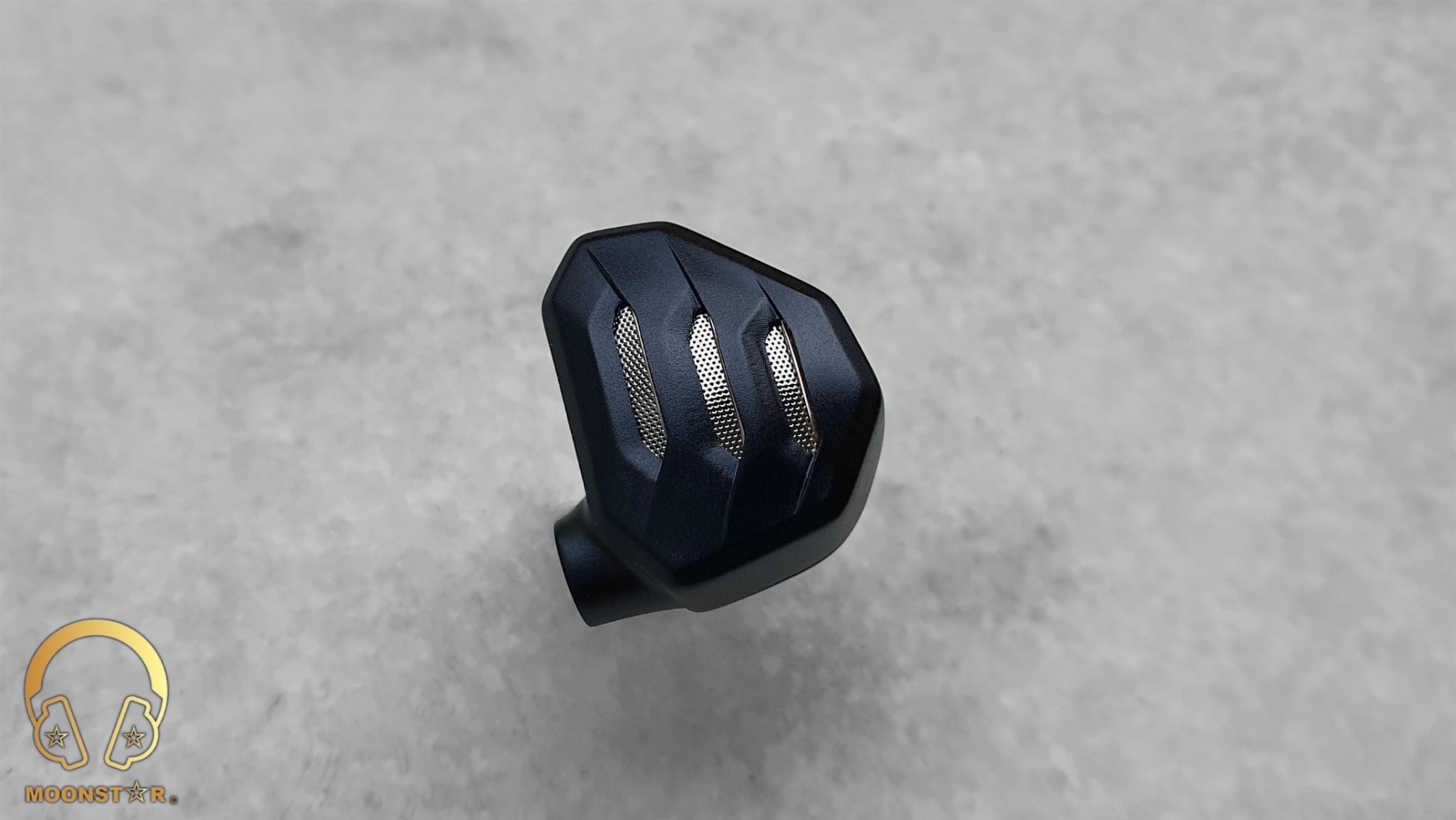
Disclaimer:
I would like to thank FiiO for providing the FiiO FH7S as review sample. I am not affiliated with FiiO beyond this review and all these words are reflecting my true and unaltered opinions about the product.
Price & Availability:
The actual price of the FiiO FH7S is 399.99 US$. More information’s can be found under the links below;
Package & Accessories:
The FiiO FH7S has a rectangular box same like the lasted generation IEM’s of the company. However the box is relative smaller than previous models, which I do prefer this sort of box material since it is a more environment friendly choice. The main box comes wrapped with a fancy looking cardboard sleeve that features the product illustration and some product related brandings on the top.
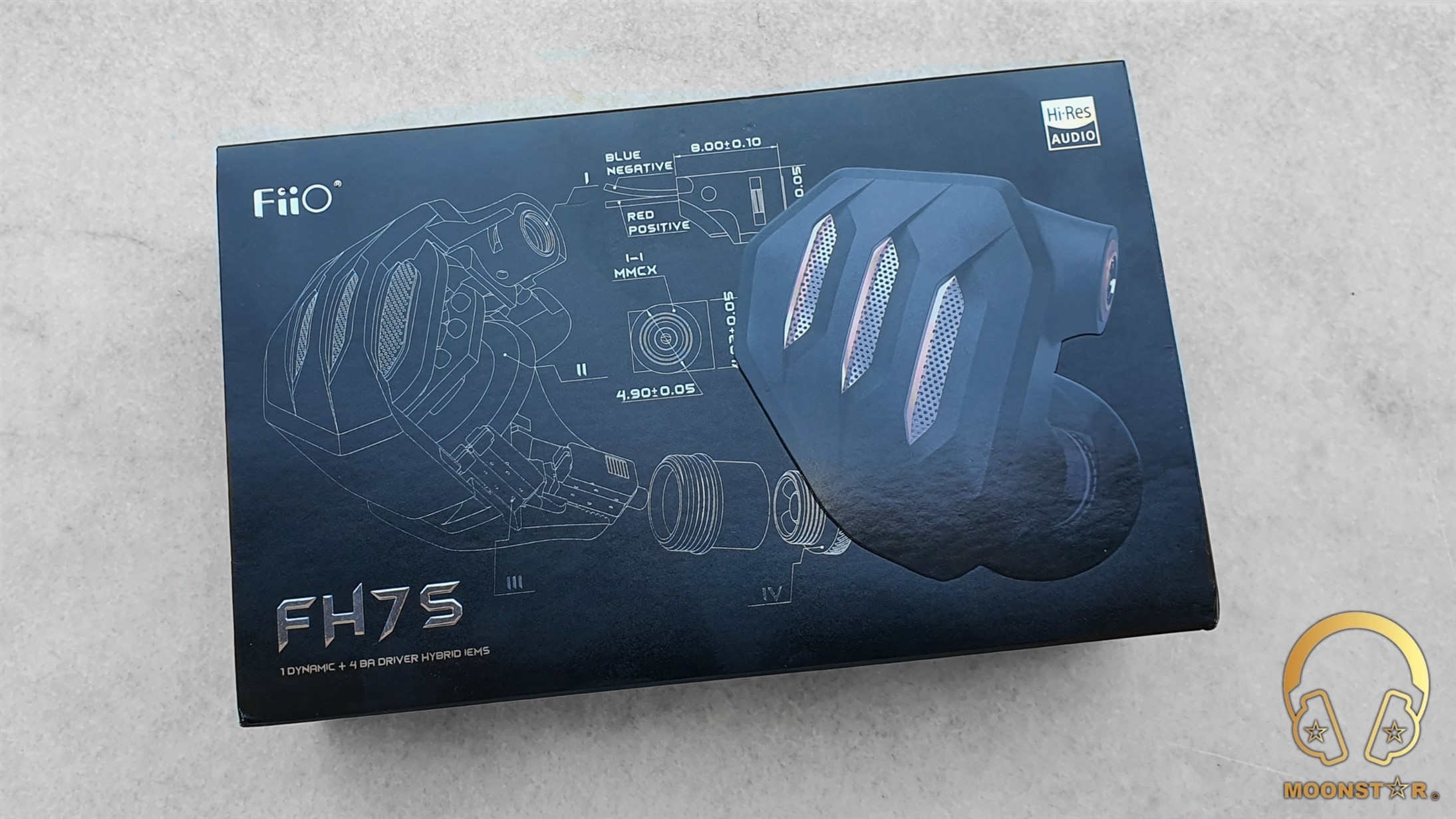
After you remove the cardboard sleeve you will see the main box in black color that sport a sketch of the FH7S on the top and the motto of the company, which is “born for music”.
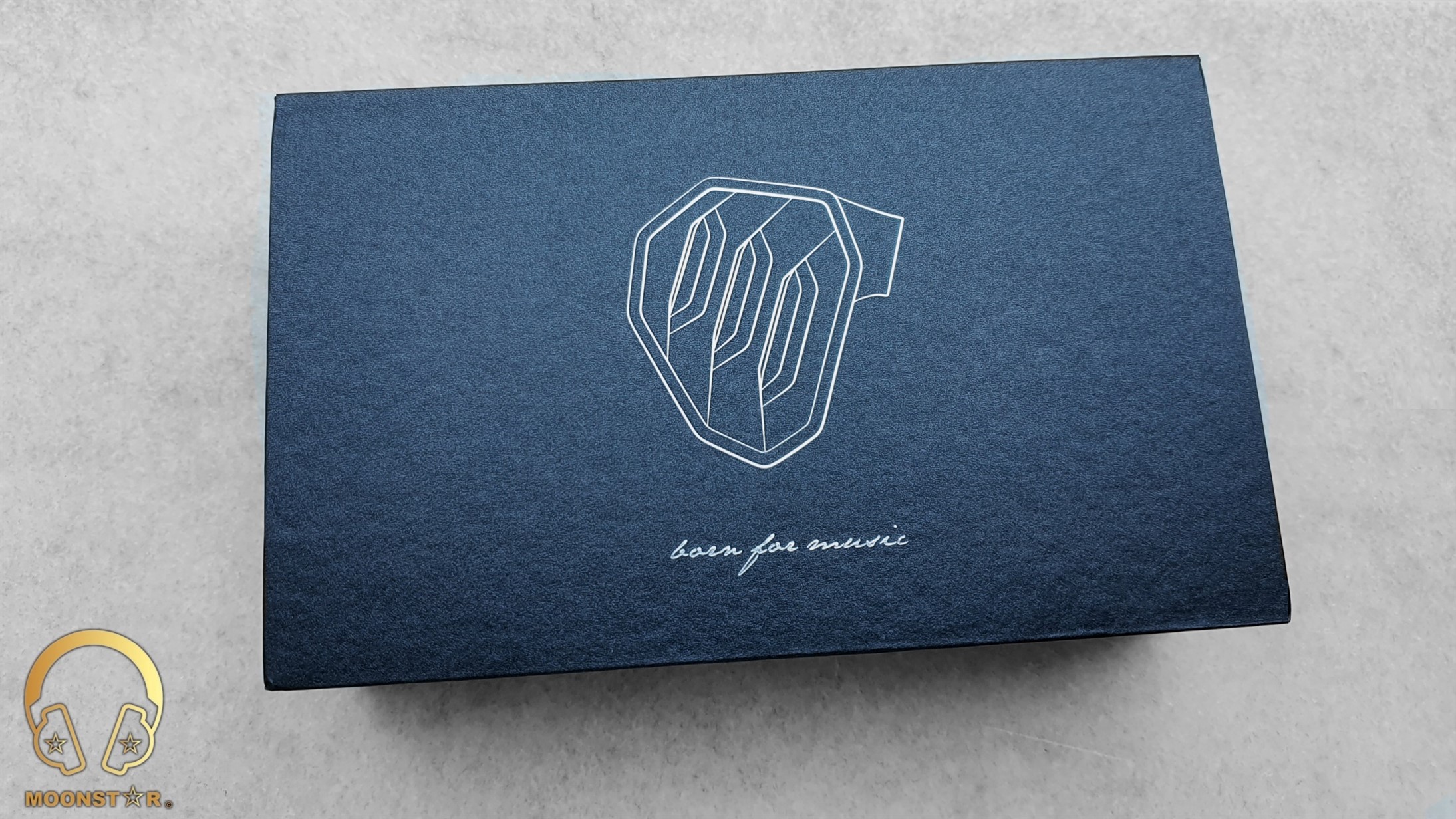
This box of the FiiO FH7S comes with the following items/accessories;
- 1 pair x FiiO FH7S Hybrid In-Ear Monitors
- 1 piece x 8 Core detachable cable with MMCX connectors
- 2 pieces x Swappable Headphone Plugs (1x 3.5mm SE, 1x 4.4mm Balanced)
- 3 pairs x Interchangeable Audio Filters (Green, White, Red “White one came Pre-installed”)
- 3 pairs x FiiO HS18 Ear tips (S/M/L)
- 3 pairs x Bass Ear tips (S/M/L)
- 3 pairs x Vocal Ear tips (S/M/L)
- 3 pairs x Balanced Ear tips (S/M/L)
- 3 pairs x SpinFit Ear Tips (S/M/L)
- 2 pairs x Double Flange Ear tips (M/M size)
- 2 pairs x Memory Foam Ear Tips (M/M size)
- 1 piece x HB5 Storage Case
- 1 piece x Cleaning Brush
- 1 piece x SK1 Magnetic Cable Organizer
- 1 piece x MMCX Assist Tool
- 1 piece x Warranty Card and User Manual
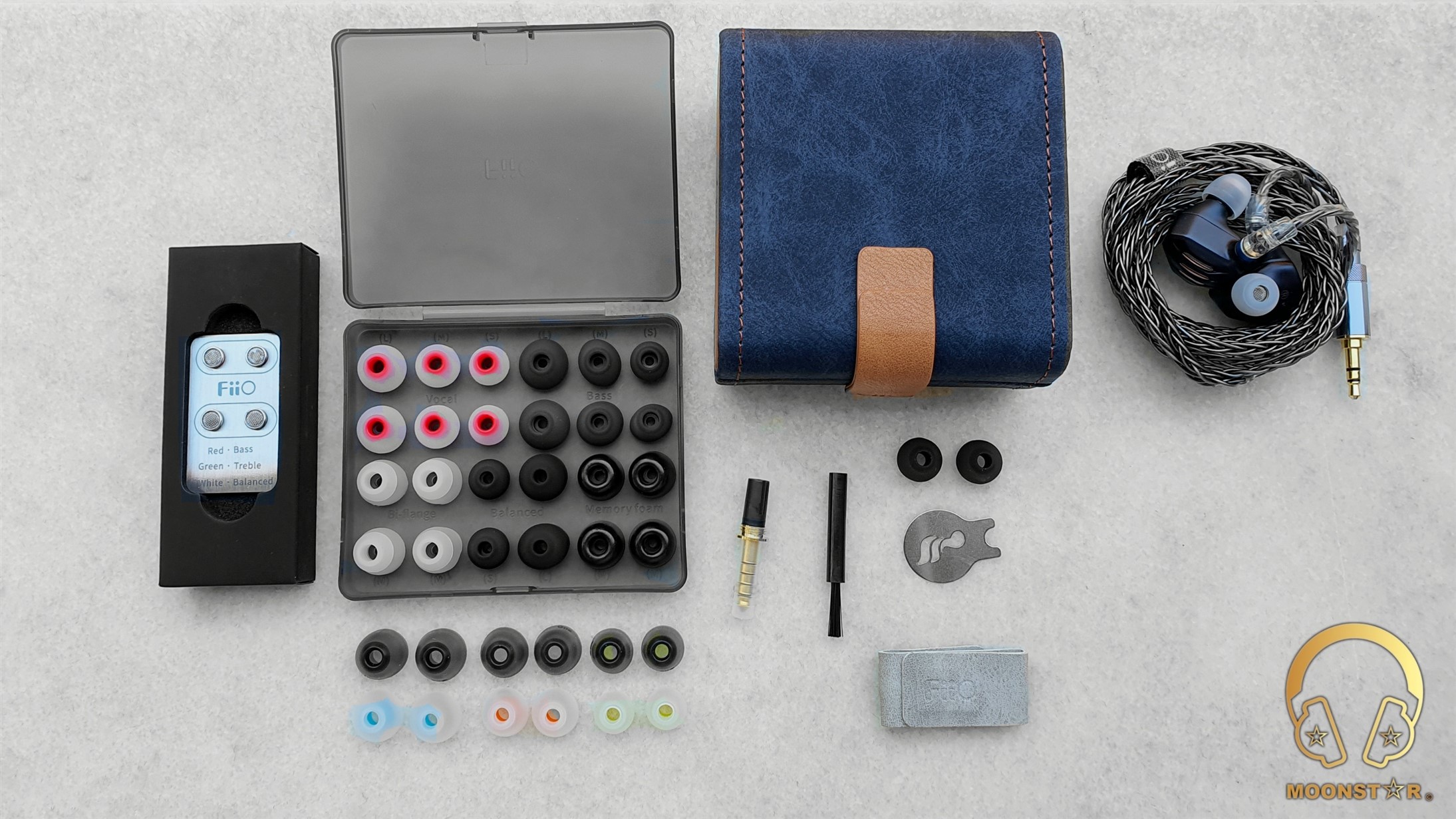
The FiiO is known for its rich ear tips selection that comes with their In-Ear Monitor and the FH7S is not an exception that I have already listed above. However, one of the ear tips are an FH7S exclusive that has the model description HS18.

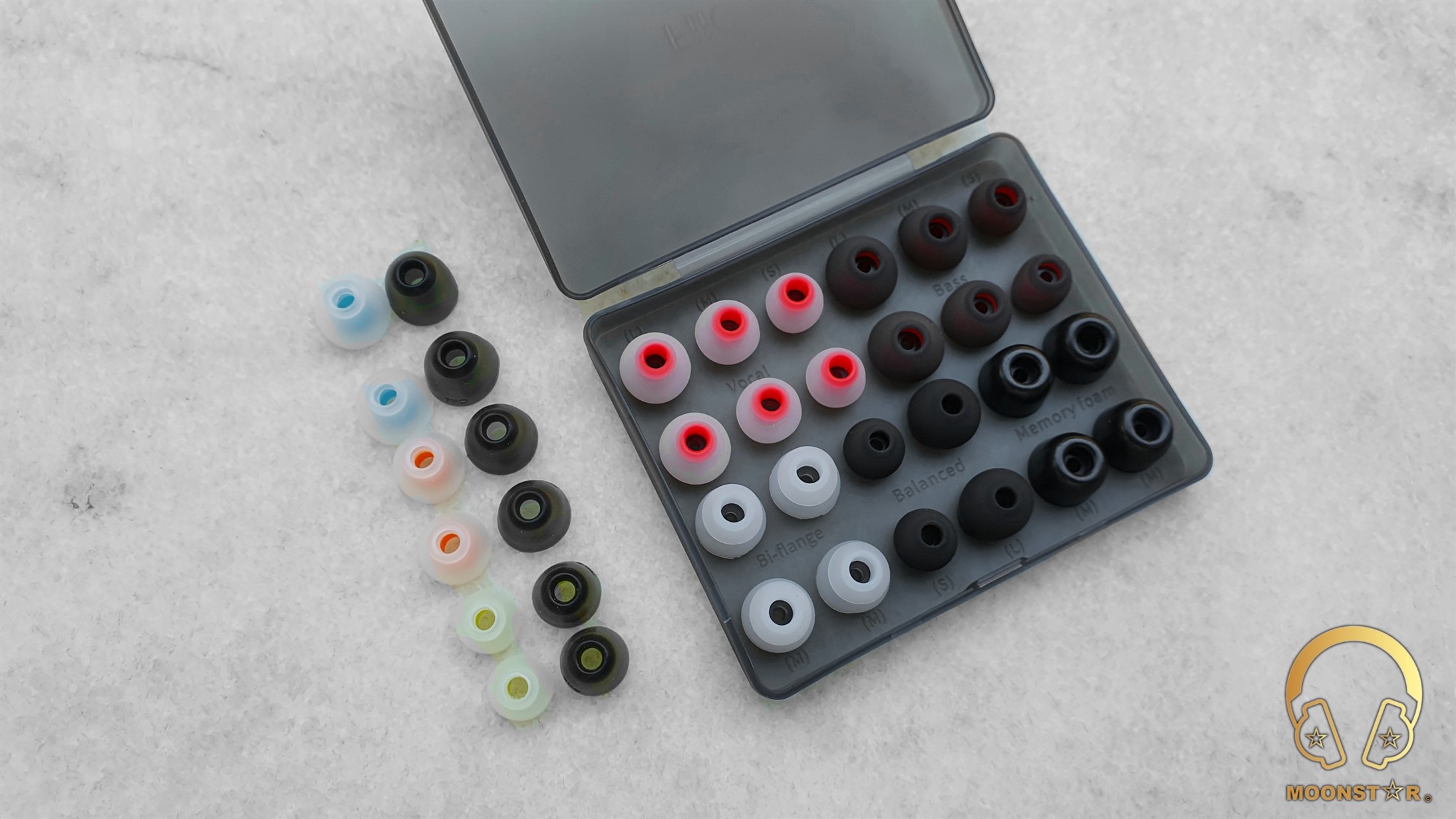
The HB5 storage case is a premium looking accessory in blue and brown color that we know from pervious IEM’s like the FD7, FH9 and FH5s/5S Pro.


The SK1 Magnetic Cable Organizer, a cleaning tool the and the FiiO MMCX Assist Tool are some nice additions.
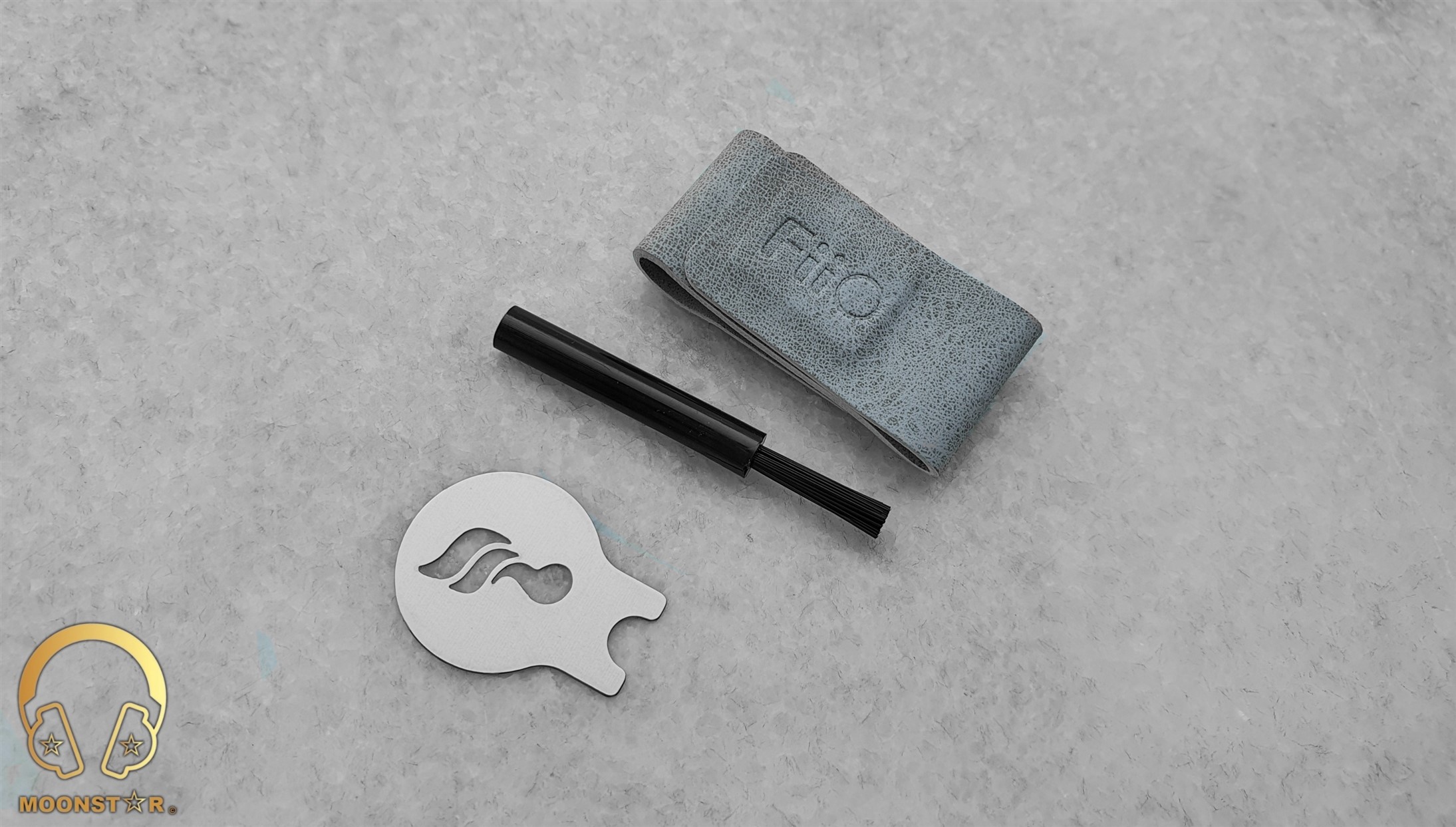
Design & Build Quality:
The new FH7S reflects a more edge-like monitor shape with slightly rounded corner compared to previous IEM’s like the FH3, FH5, FH7 and FH9 that do have a more rounded overall monitor shape. The FH7s looks rock solid thanks to the carefully machined and assembled aluminum alloy housing that features a special oxidized surface for extra scratch resistance.
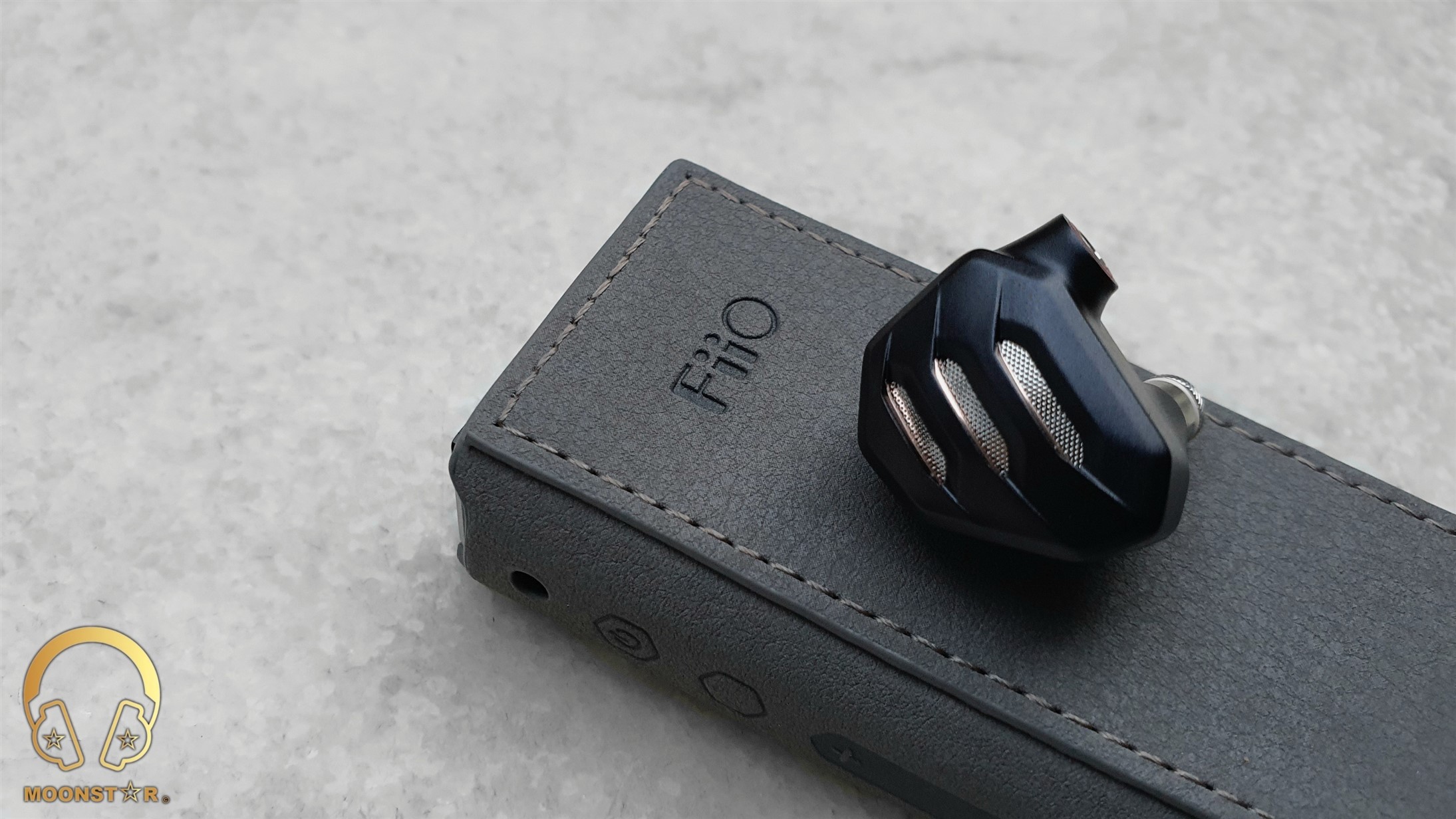
Inside the heart of each monitor is a 4BA+1DD Hybrid Driver configuration same like its predecessor the original FH7. However, it utilize a new Custom BA setup that is a combination of DFK driver customized by FiiO and Knowles that is dedicated for the Midrange and a SWFK-31736 setup that is responsible for the treble area. Another update is the 2nd-gen FiiO-developed 13.6mm dia. DLC (Diamond Like Carbon) Diaphragm Dynamic Driver that will be responsible for the lows.
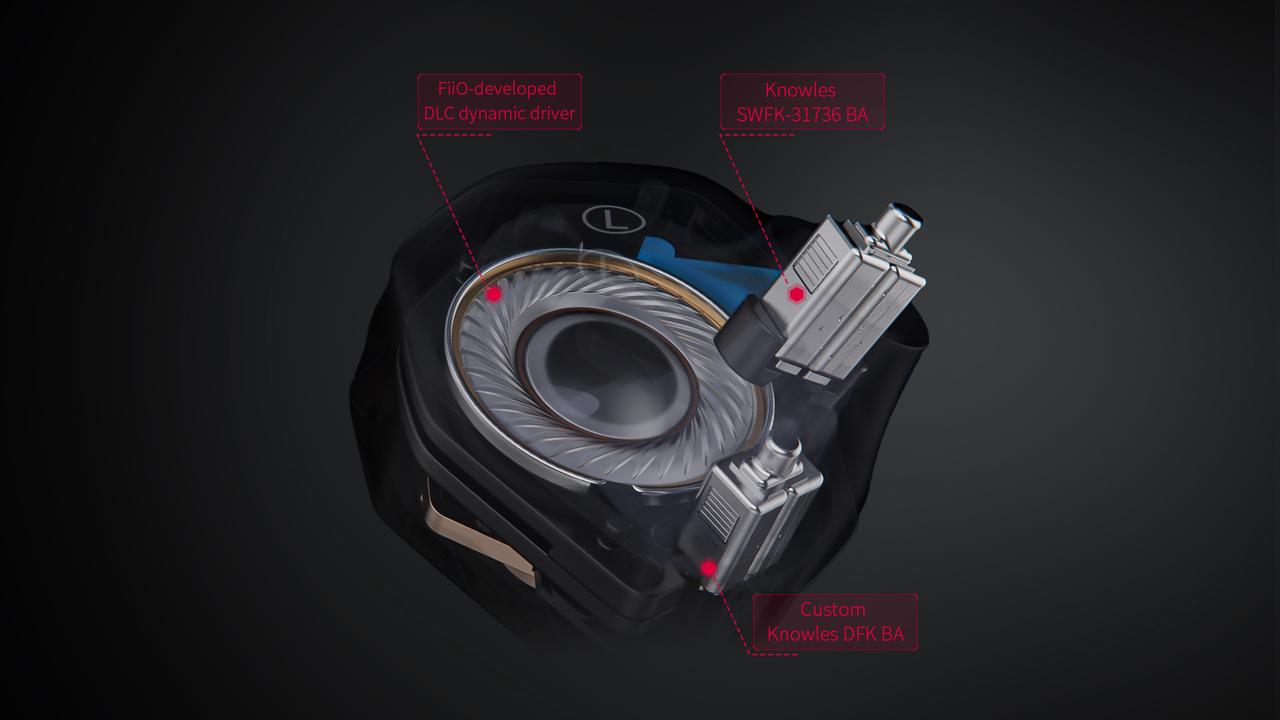
On the front of the monitor shell is the gorgeous looking faceplate that is called “Sci-Fi Armor Design” by FiiO. Here are very small layers of carefully-placed holes that are stacked upon each other that forms the unique semi-open design.

This semi-open design incorporates FiiO’s balanced pressure relief system that is located between the front and rear cavities. This system reduces the resistance of the air created by the 13.6mm diameter large Dynamic Driver.

At the rear body of the monitor housing are the L (left) and R (Right) markings and the sound nozzle that do have a fine metal mesh on the top to prevent the insertion of strange particles such like dust and ear wax.
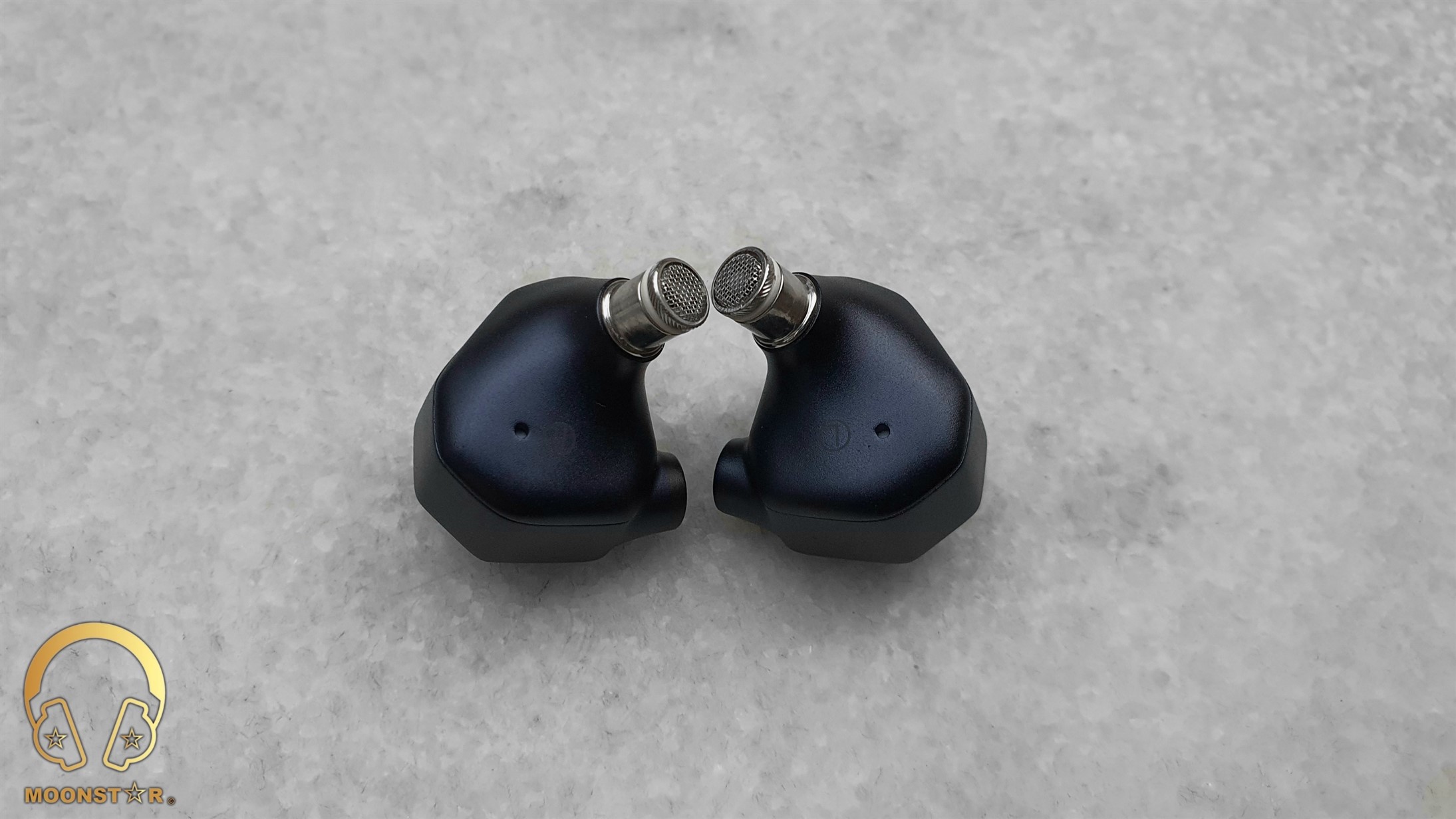
You can install one of the 3 swappable sound tuning filters that do have a fine metal mesh on the top to prevent the insertion of strange particles such like dust and ear wax.

On the top of the monitor housing is the MMCX (Micro Miniature Coaxial) female connectors with left and right color indicators, which is in blue for left and red for the right connector.

The overall build quality of the monitors is top notch same like other FiiO products, without to show any imperfections such like gaps, burs, etc.
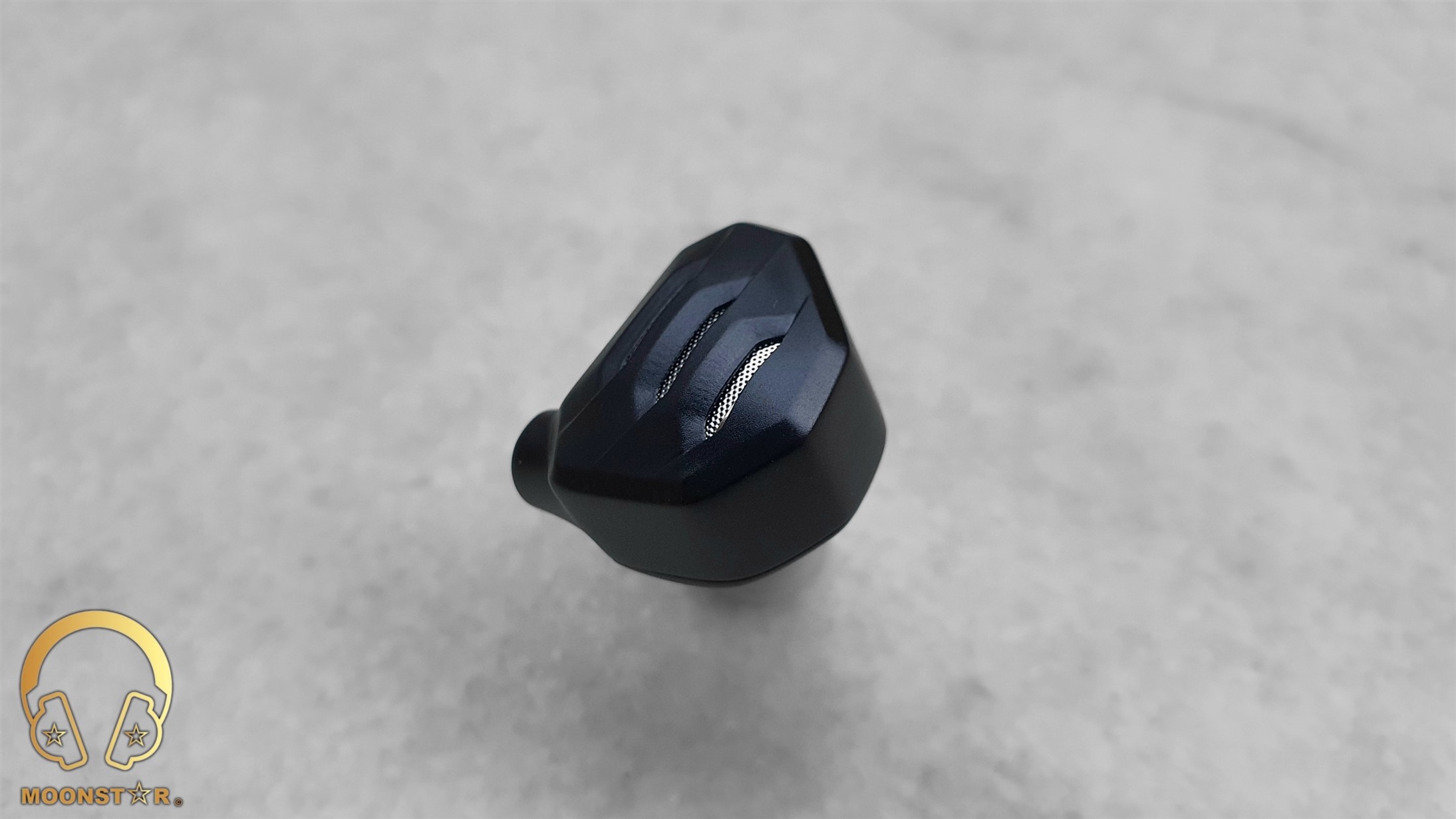
The FiiO FH7S comes with an 8 strand High Purity Silver Plated Monocrystalline Copper wire cable that has 19 wires per stand, which makes 152 wires in total.
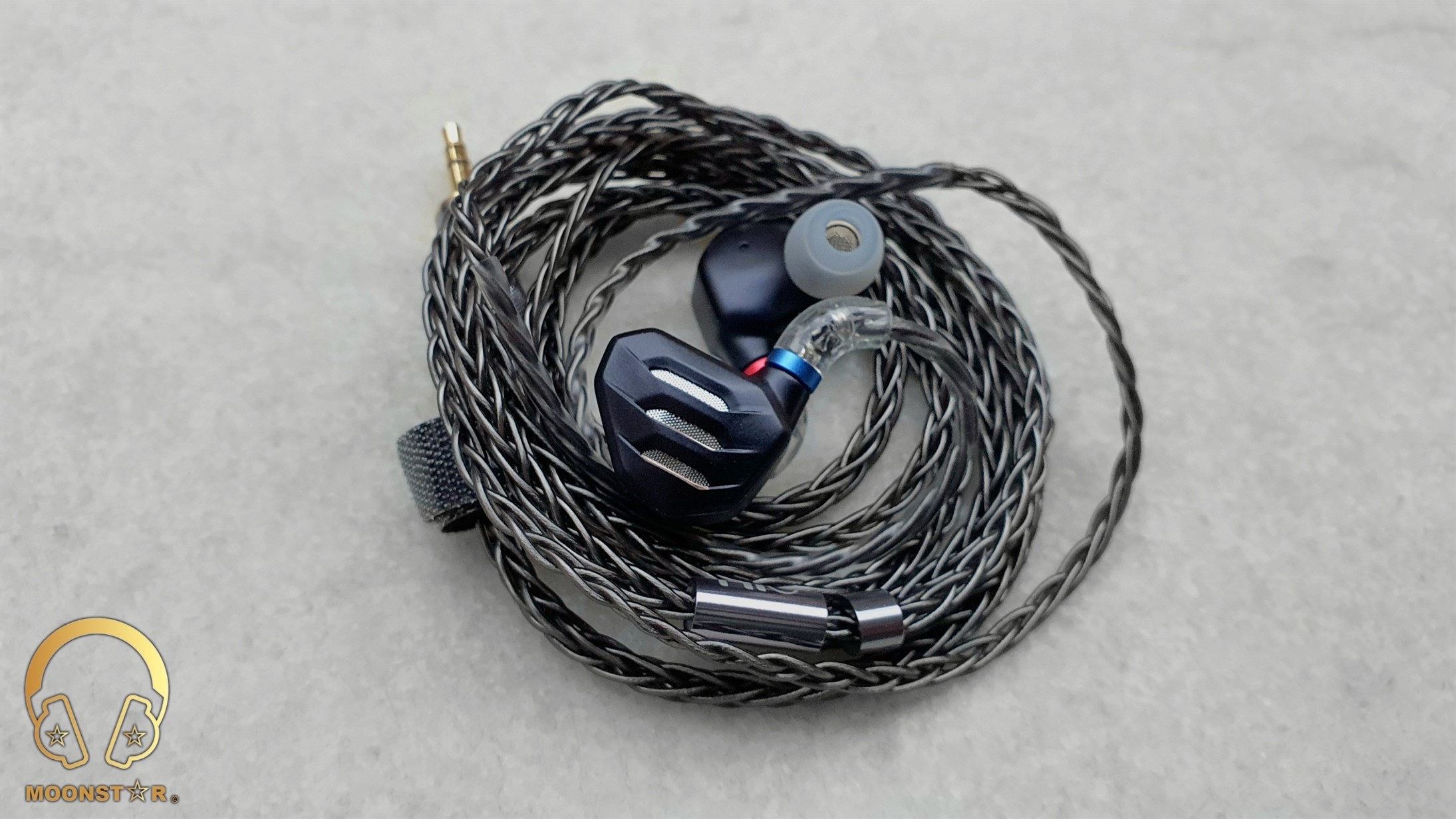
The cable features special isolation made from environmentally friendly German TPU material in black color. This TPU material is also resistant against yellowing after long-term use and against stiffening when in low-temperature environments.
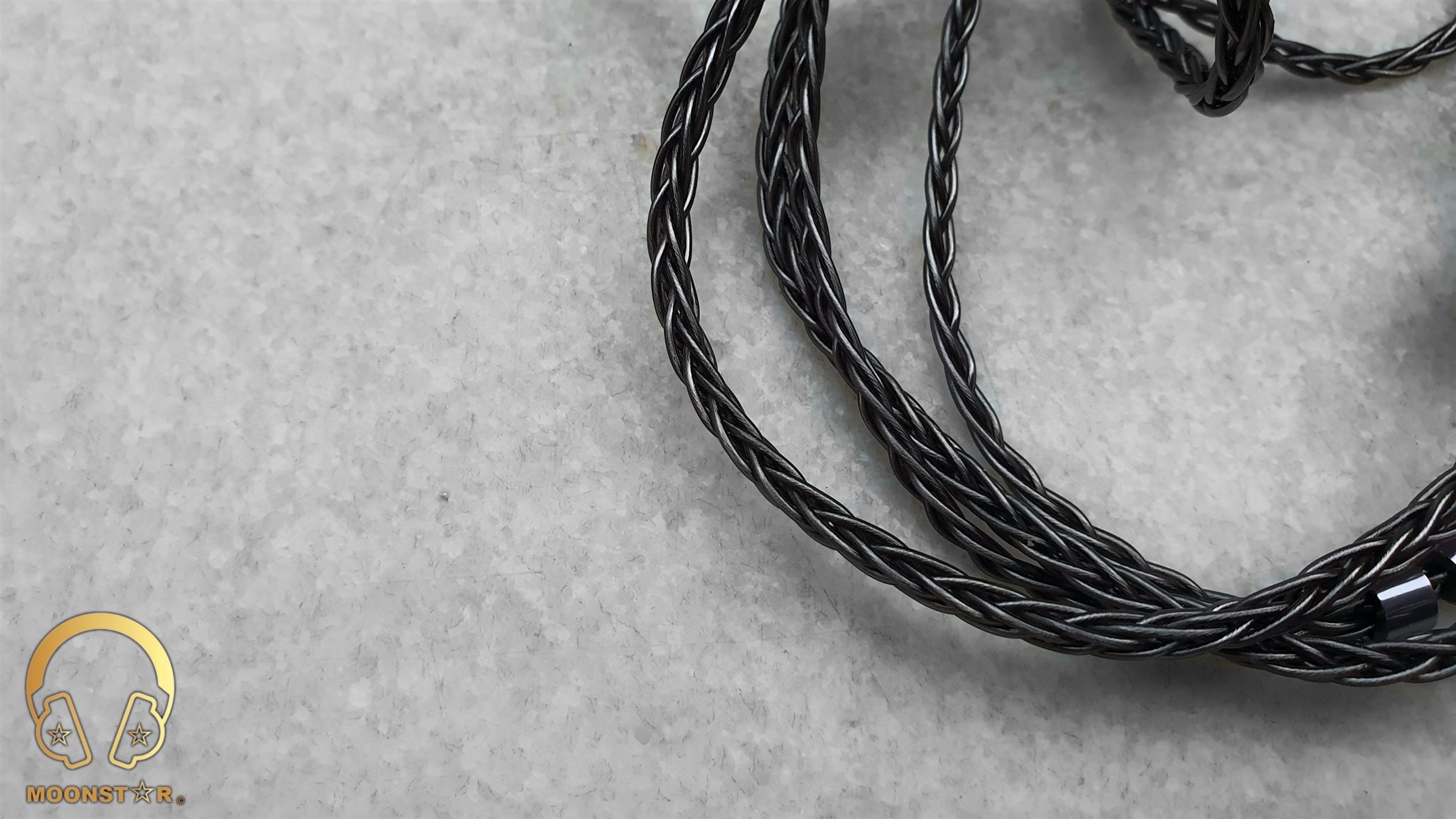
The MMCX connectors have a transparent housing and on each connector is right left indicator, which is a red ring on the right and a blue ring on the right connector.
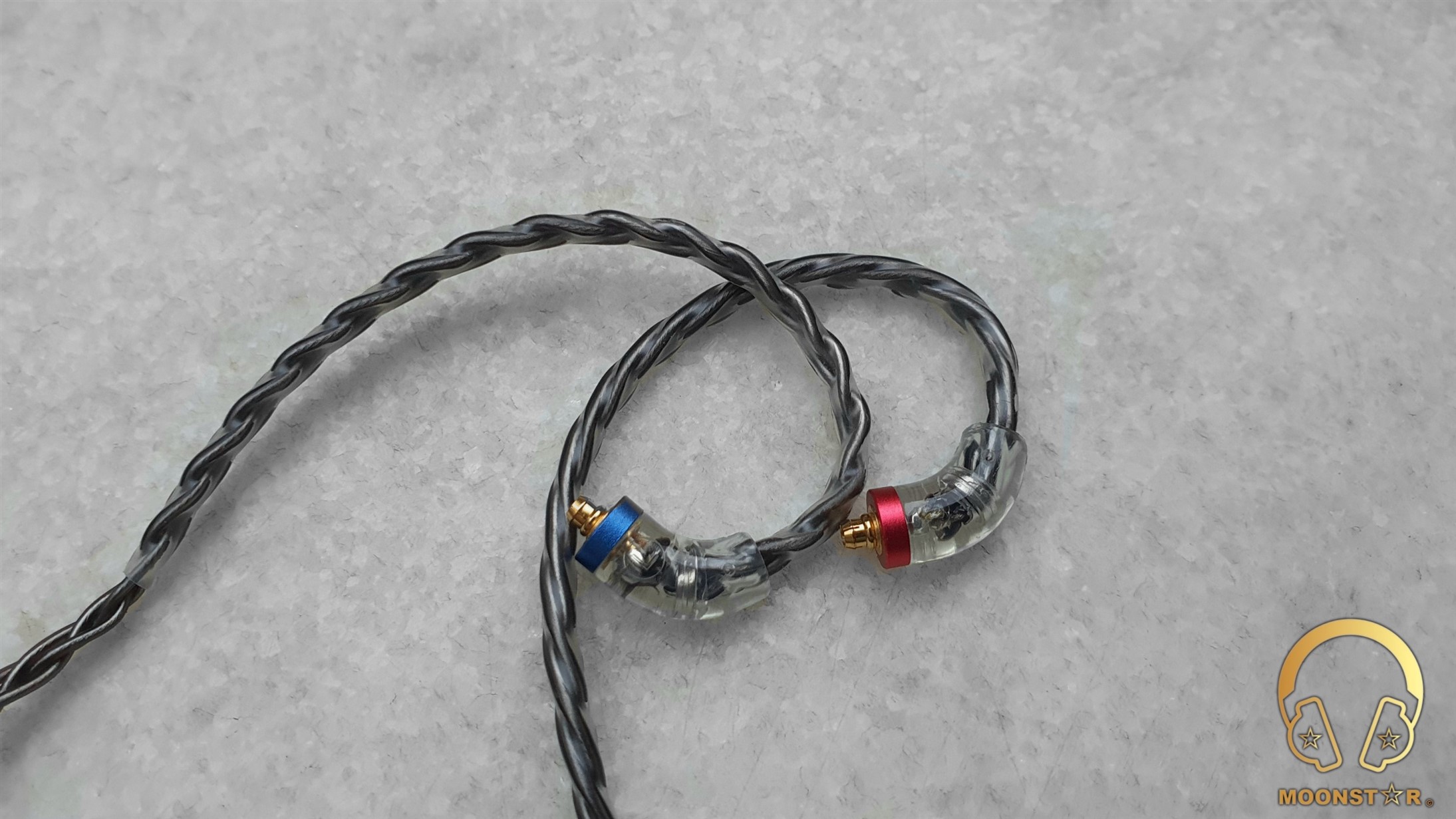
Near the MMCX connectors are transparent heat-shrink ear hooks for a better over the era wearing experience.

The cable sports a chin slider and y splitter made from metal material. The y splitter has the FiiO branding on the top.

A remakbale feature of the cable is FiiO’s latest Twist-Lock Interchangeable audio plug design that comes with 1x 4.4mm TRRRS Balanced and 1x 3.5mm Single Ended TRS plugs. The housing of the headphone plug has a strait profile and is made of the same metal material with a glossy finish.

Comfort & Isolation:
The FiiO FH7S is a relative small IEM that has a quite ergonomic monitor shape, which fits quite comfortable to my ears with an average ear concha. I really like the shape of the monitors that doesn’t hurt my ears even after longer listening periods.
The passive noise isolation of the FH7S is on an average level, due to the semi-open back design. However, the passive noise isolations is fairly enough for the use in relative noisy environments such like a bus or train.

Efficiency & Pairing:
The FiiO FH7S is a relative efficient In-Ear Monitor thanks to an impedance of 18Ω and a sensitivity of approx. 104dB/mW. Sources with relative weak amplification such as Mobile Phones, Tablets or regular Headphone Adaptors are able to power the FH7S to fairly high volume levels. However, to hear the true potential of this IEM, I highly recommend to pair it with more professional sources such like a DAP’s (M11/M11 Plus), DAC/Amplifiers (BTR7/BTR5) or USB DAC Dongles (FiiO KA3/KA1).
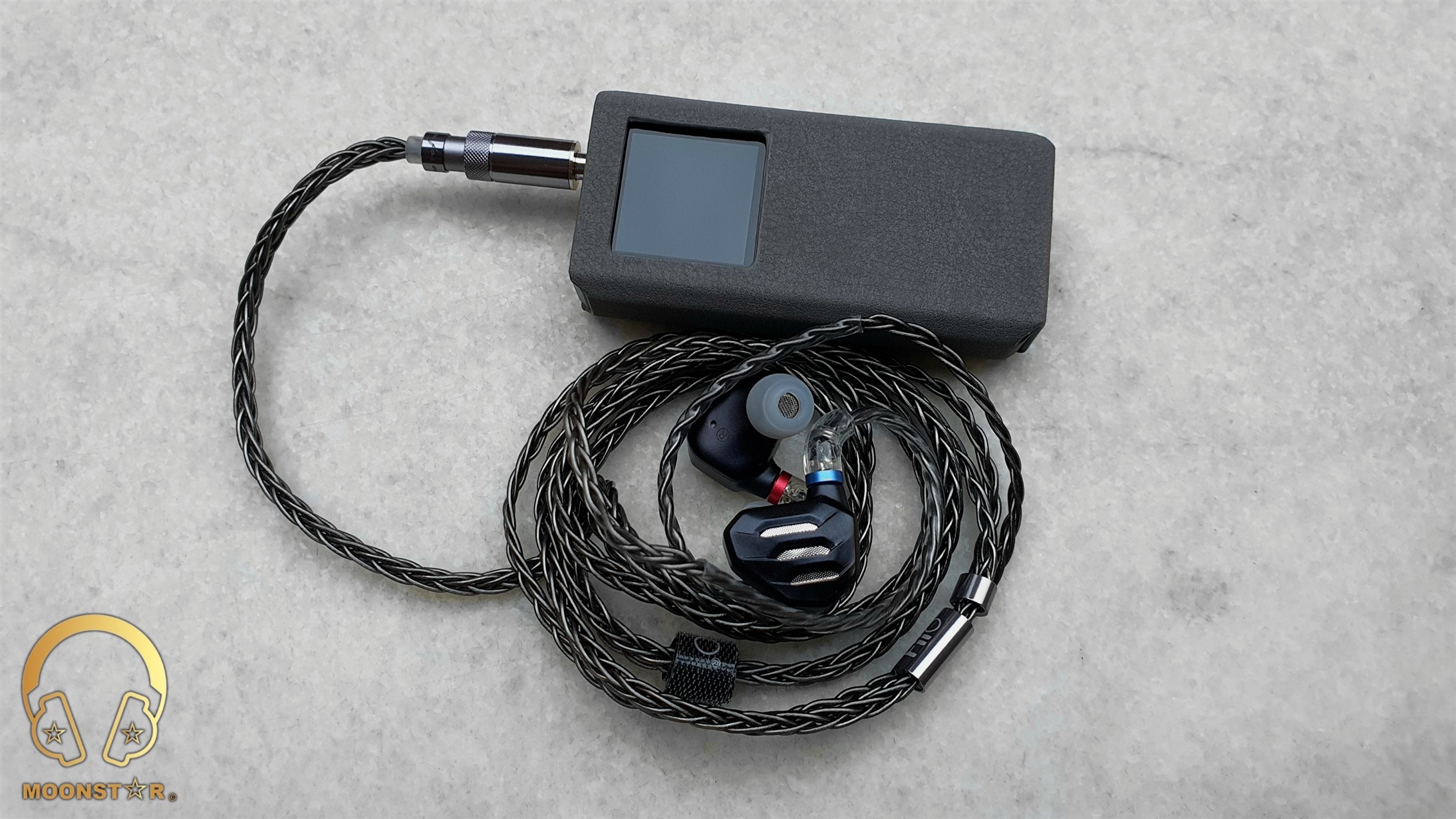
Technical Specifications:
- Driver Configuration : Hybrid Configuration
- Driver type : 1x 13.6mm diameter Dynamic Driver + 4x Balanced Armature Drivers
- Frequency response : 10Hz- 40kHz
- Sensitivity : 104db/mW
- Impedance : 18 Ω
- Plug : Interchangeable Plugs (3.5mm SE and 4.4mm Balanced)
- Connector Type : MMCX Connector
- Cord Length : 120cm
- Wearing Type : Over the Ear

Complete List of Features:
- 1x Dynamic Driver + 4x Balanced Armature Drivers Hybrid Driver Setup
- 13.6mm diameter DLC Diaphragm Dynamic Driver
- 4 custom Knowles BA
- Sci-Fi Armor design
- Unique notch filter
- 2nd-gen semi-open design
- 8 strands totalling 152 silver-plated monocrystalline copper wires
- Twist-lock swappable audio plugs
- New FiiO silicone ear tips HS18
- Patented S.TURBO acoustic design
- 3 tuning filters
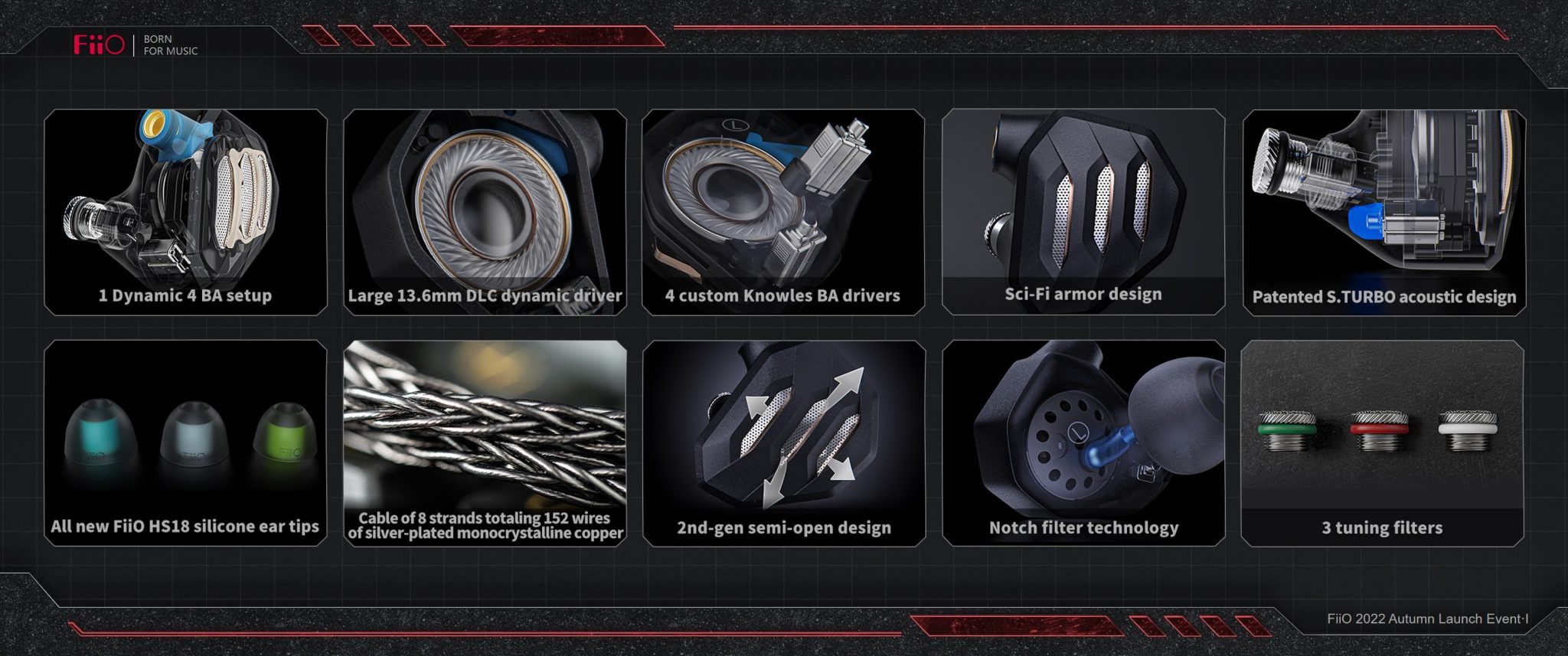
Sources used for this review:
- IEM : FiiO FH7S, Oriveti OH500, Dunu DK3001 Pro
- DAP/DAC/AMP : FiiO M11 Pro, FiiO BTR7
Albums & tracks used for this review:
- Adele – My Little Love (Spotify)
- Randy Crawford – On Day I Will Fly Away (Flac 16bit/44.1kHz)
- Hayley Westenra – Odyssey Album (Dezzer HiFi)
- Dionne Warwick – Walk On By (Flac 16bit/44.1kHz)
- Sarah McLachlan – Angel (Flac 24bit/48kHz)
- Sertap Erener – Aşk (Flac 16bit/44.1kHz)
- Edith Piaf – Non Je Ne Regrette Rien (Flac 16bit/44.1kHz)
- Diana Krall – So Wonderful (DSF)
- Aretha Franklin – I Say A Little Payer (Flac 24bit/96kHz)
- Sonya Yoncheva – (Giuseppe Verdi) II Trovatore, ActI (Flac 24bit/96kHz)
- George Michael – Don’t Let the Sun Go Down on Me (Flac 24bit/192kHz)
- David Bowie – Heroes (Flac 24bit/192kHz)
- Elton John – Rocket Man ((Flac 24bit/96kHz)
- Barry White – Just The Way You Are (Flac 24bit/48kHz)
- Isaac Hayes – Walk On By (Flac 16bit/44.1kHz)
- Sting – Englishman in New York – (Flac 24bit/48kHz)
- Eric Clapton – Wonderful Tonight (Flac 24bit/96kHz)
- B. King – Riding With The King (Tidal Hi-Fi)
- Dave Gahan – Kingdom (Tidal Hi-Fi)
- U2 – Sunday Bloody Sunday (Flac 16bit/44.1kHz)
- Bro Safari, UFO! – Drama (Deezer HiFi)
- Armin Van Buuren – Vini Vici (Flac 16bit/44.1kHz)
- Daft Punk – Doin’ it Right (Flac 24bit/96kHz)
- Jo Blankenburg – Meraki (Spotify)
- Lorde – Royals (Flac 24bit/48kHz)
- Massive Attack – Angel (Flac 24bit/48kHz)
- Toutant – Rebirth (Deezer HiFi)
- Gogo Penguin – Raven (Flac 24bit/192kHz)
- Gogo Penguin – Murmuration (Flac 24bit/192kHz)
- Portishead – It Could Be Sweet (Spotify)
- Max Richter – On the Nature of Daylight (Flac 24bit/96kHz)
- Charly Antolini – Duwadjuwandadu (Flac 24bit/192kHz)
- Ferit Odman – Look, Stop & Listen (Flac 24bit/192kHz)
- Chopin – Nocturn No. 20 In C-Sharp Minor (Flac 16bit/44.1kHz)
- Fazıl Say – Nazım Oratoryosu (Live) (Flac 16bit/44.1kHz)
- Vivaldi – Le QuarttroStagioni “The Four Season” (Deezer HiFi)
- Otto Liebert& Luna Negra – The River (Flac 24bit/192kHz)
- Lunatic Soul – The Passage (Flac 16bit/44.1kHz)
- Deftones – My Own Summer (Shove it) (Flac 16bit/44.1kHz)
- Metallica – Sad but True (Flac 24bit/96kHz)
- Opeth – Windowpane (Flac 16bit/44.1kHz)
- Megadeth – Sweating Bullets (Tidal Hi-Fi)
- Rush’s – Leave That Thing Alone (Flac 16bit/44.1kHz)
- Slayer – Angel of Death (Spotify)
- Liquid Tension Experiment 2 – Acid Rain (Spotify)
- Yosi Horikawa – Bubbles (Spotify)

The Sound:
The FH7S is the successor of the original FH7 that came also with a 4BA+1DD Hybrid Driver configuration. The new hybrid IEM has a moderately warm tonality that is not overdone, while instruments are reproduced with a relative natural timbre. The general sound profile of the FH7s shows a nice fusion of dynamism, musicality and resolution across the sound spectrum. The lows are full bodied, impactful yet petty controlled. The midrange on the other hand sounds mildly warm, transparent and clear, while the treble range is shown with a decent level of brilliance, airiness and extension.
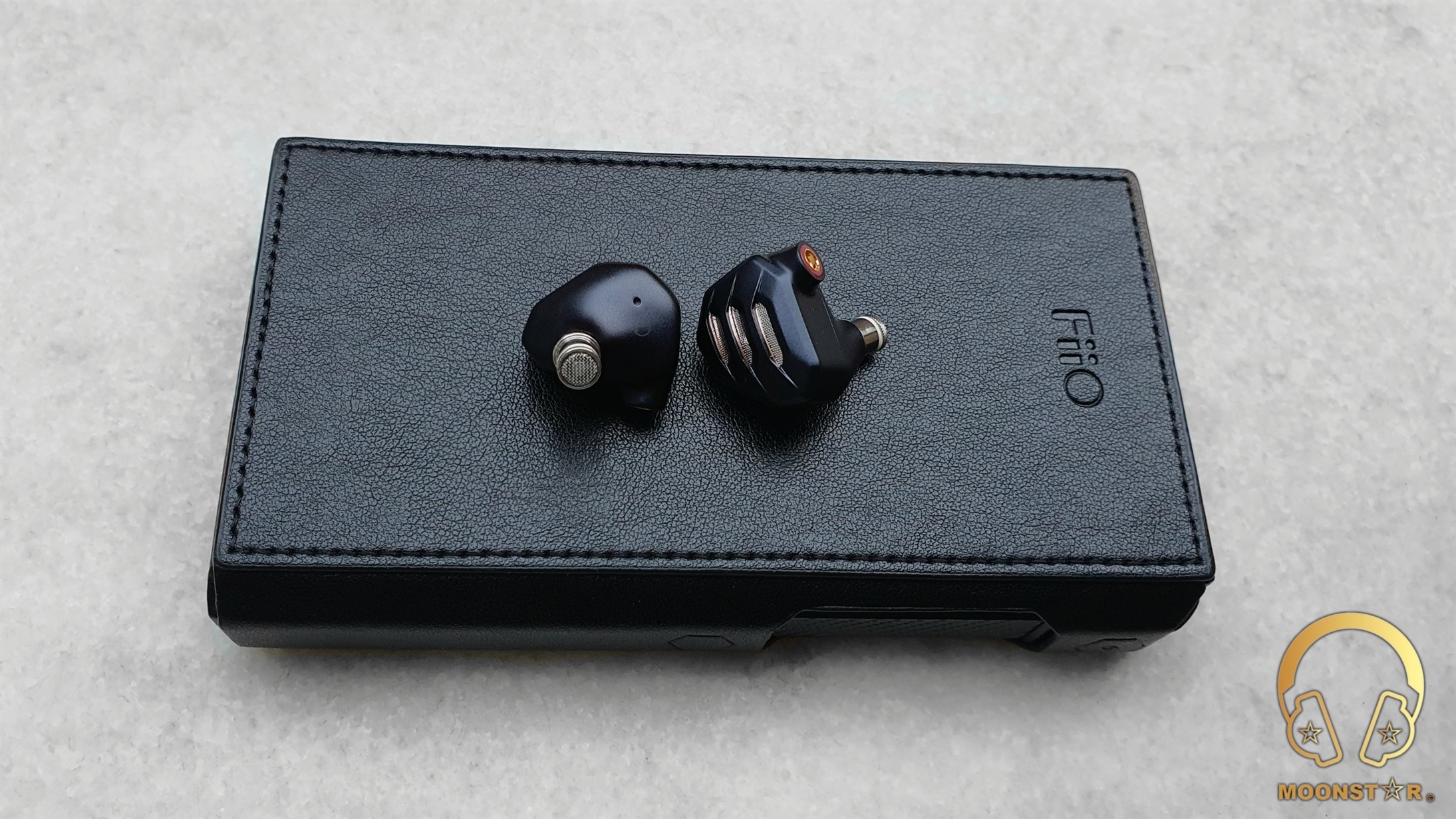
Tuning Filters Explained:
- White Filter:
- Red Filter:
- Green Filter:
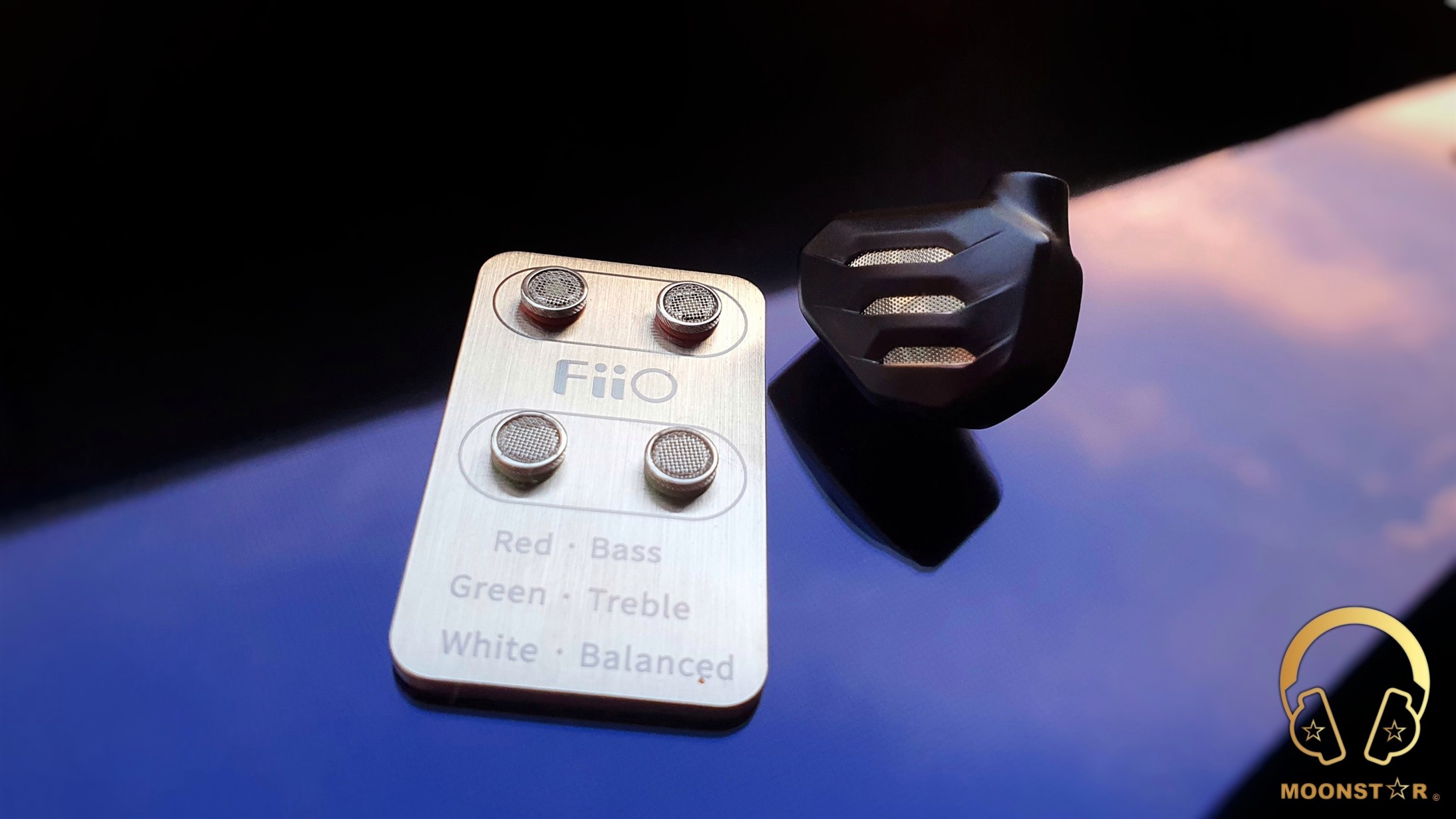
The FiiO FH7s review has been written after a burn-in period of about 70 Hours. I have used the stock 8-Core Silver-Plate Monocrystalline cable and the HS18 Silicone Ear Tips in combination with the White Sound Tuning Filter that are included to the package. My sound impressions below are mainly based on auditions over the FiiO M11 Plus and FiiO BTR7.
Bass:
The lows of the FiiO FH7S are produced by the 13.6mm diameter large DLC (Diamond Like Carbon) Diaphragm Dynamic Driver, which doesn’t shows any driver-flex issues thanks to the semi-open acoustic design. The focal point of the lows is the midbass region that sounds slightly more pronounced compared to the subbass area. The subbass performance of the FH7S is quite decent that is powerful, deep and well extended. The subbass rumble that is an important part in tracks such as Lorde’s “Royals”, Massive Attack’s “Angle” or Armin Van Buuren’s “Vini Vici” sound quite exiting.
The midbass region, which is slightly more highlighted in the lower register, sounds pretty strong and impactful. Instruments such like cross and kick drums for example are reproduced with a good sense of body, speed and control. Songs with complex bass passages such like Gogo Penguin’s “Raven” and Charly Antolini’s “Duwadjuwandadu” are represented in a pretty fast and controlled manner. What I do really like about the general bass character of the FA7S is the softness and naturalness of the bass notes that are produced by the relative large 13.6mm dia. dynamic driver.
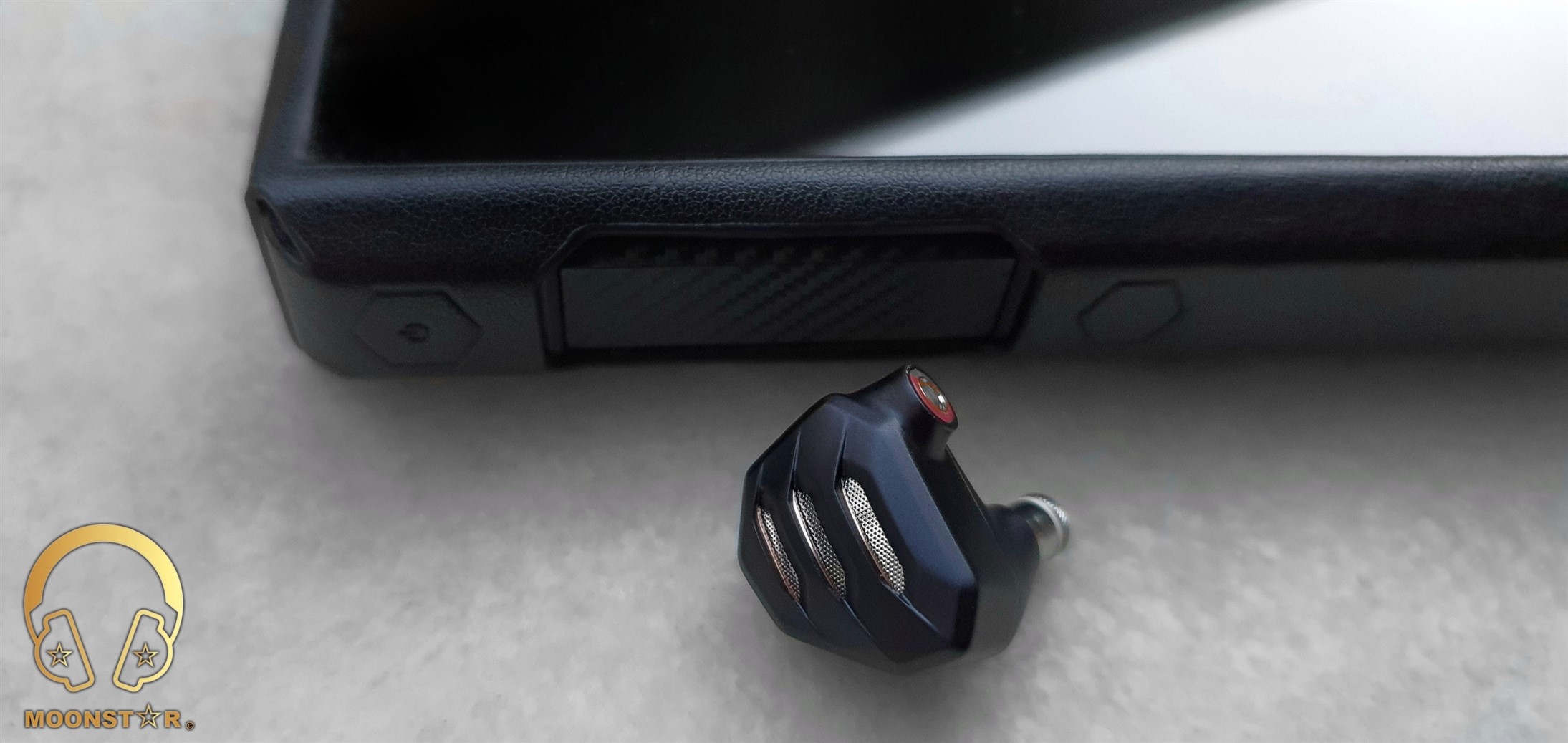
Midrange:
The FiiO FH7S offers a pretty transparent and airy overall midrange presentation, which shows an above average clarity and resolution. The midrange has a relative smooth character while the tonality mildly warm that is created in the lower midrange area.
The FiiO FH7S has just the right level of lower midrange depth and body, when I do listen to vocals like Barry White, Dave Gahan or David Bowie. The clarity and resolution is on a sufficient level that meets my expectation form an In-Ear Monitor at this price level. Instruments on the other hand are reproduced in a quite musical, clear and detailed manner. Strings for example like violas, acoustic guitars or cellos do have just the right grade of transparency, depth and fullness for a musical presentation.
The upper midrange stands out with its relative smooth and nicely controlled overall tuning that is able to create a good sense of clarity and extension when I do listen to both vocals and instruments. Female vocals from Adel and Diana Krall up to Sarah McLachlan are presented in a pretty lively, intimate and detailed manner. Instruments on the other hand do sound slightly softer & smoother than normal, while the level of clarity and resolution that is created in the upper midrange is on a decent level. Pianos, side flutes or violins do sound pretty vivid and detailed, and are shown with a good sense of extension, without to show any remarkable negative conditions like sharpness.
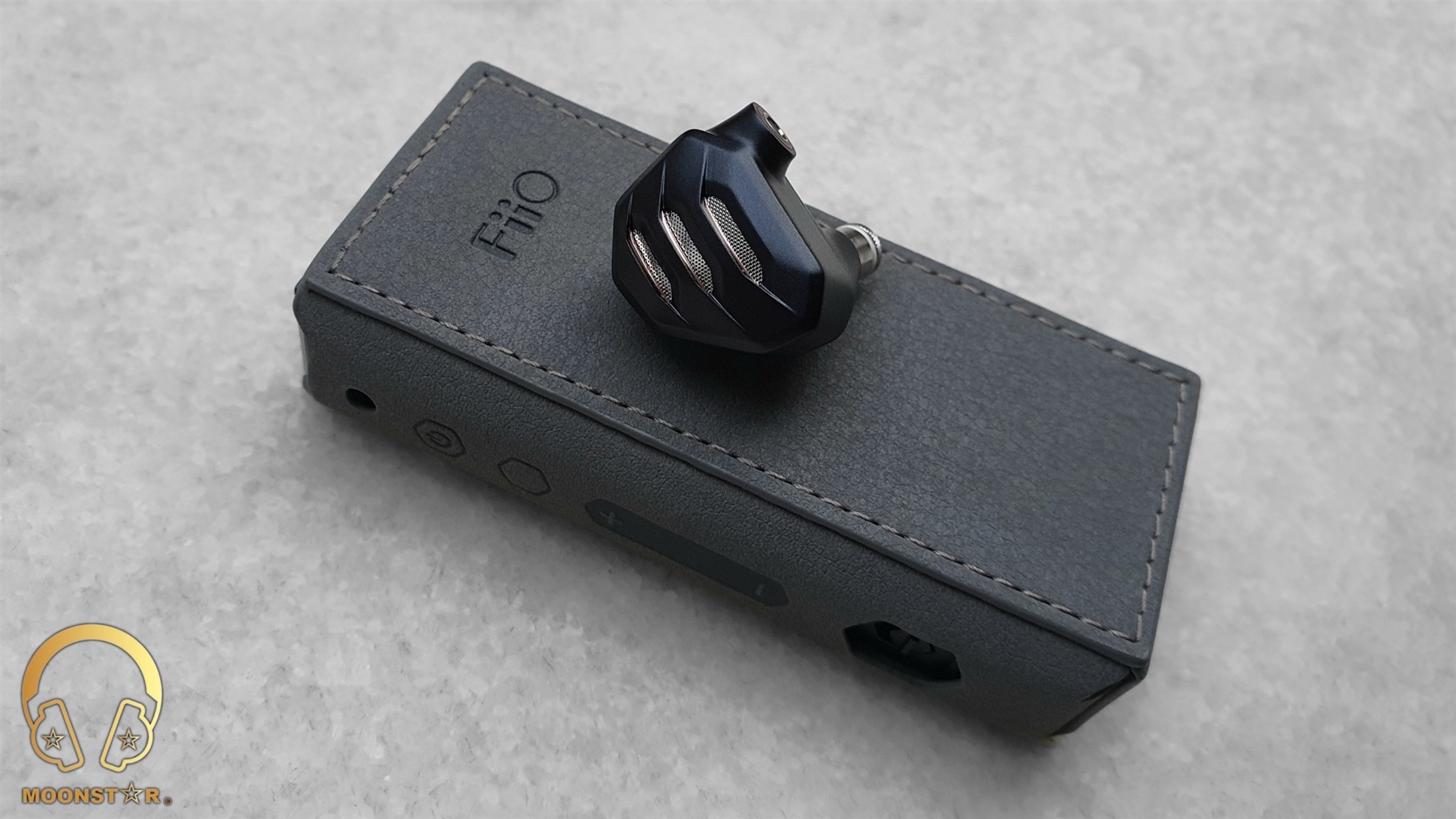
Treble:
The treble range of the FiiO FH7S can be described as crisp yet controlled. This area sounds moderately bright, fatigue free and detailed from the brilliance up to the presence. The transitions from the upper midrange towards the lower treble area are highly controlled in moments when instruments such like an electro guitar is play with high level of distortion. The lower treble area is moderately highlighted, which shows a smooth and highly controlled character. Instruments like hi-hats, snare drums or violins are reproduced with an efficient sense of clarity and definition, while the extension is slightly short.
This upper treble region shows is slightly more pronounced and detailed compared to the lower treble region. This area shows an audible peak around the 7 kHz region, which is a popular adjustment these days in order to add the overall treble presentation airiness and sparkle. Percussions like snare drums and cymbals or to brass instruments like trumpets are reproduced with authority and dynamism, without to show any negative conditions such like over-sharpness. Here is a controlled roll-off right after the 8 – 9 kHz region that was quite audible even with the Green Treble filter, which offers a slightly better grade of extension compared to the White (Balanced) and Red (Bass) filters.

Soundstage & Imaging:
The FiiO FH7S offers an excellent performance in terms of separation and placement of both instruments and vocals, especially compared to similar priced IEM’s. The Semi Open-Back design is able to create a pretty spacious and airy soundstage atmosphere, which shows a good sense of depth and wideness.
Some Comparisons:
FiiO FH7S versus Oriveti OH500:
The Oriveti OH500 is another Hybrid IEM with a 4BA+1DD driver configuration that stands out with its entertaining bass performance, which shows a relative warm sound signature.
The Oriveti OH500 shows a warmer tonality and fuller overall sound profile with focal point in the lows and lower midrange area. The FiiO FH7S on the other hand has a more versatile tuning that is more balanced in direct comparison. The subbass region of the OH500 shows more depth, rumble and has a sense of extension. However, the FH7S is superior when it comes to the decay, clarity and resolution in this area that the OH500 is missing. The midbass region of both IEM’s is pretty close in terms of impact and intensity, while the FH7S has the slightly edge when it comes to the resolution, authority and speed.
The midrange of the Oriveti OH500 shows a warmer tonality and a fuller overall character, with focal point in the lower midrange register. The FiiO FH7S sounds livelier, clear and airy thanks to its semi open-back design general midrange tuning. The lower midrange of the OH500 creates a higher sense of body and depth that is especially audible when I listen to male voices or instruments such like percussions. The FH7S on the other side sounds more transparent and a bit more detailed in this area.
The upper midrange and treble region of the FiiO FH7S is slightly more pronounced and offers a higher grade of airiness and resolution. The FH7S has also the upper hand in the upper midrange and lower treble register, when it comes to the authority, speed and extension that was quite audible when I have listen to soprano voices and to instruments such like cymbals, pianos or violas. The treble range of the Oriveti OH500 sounds a bit muddy and is missing some clarity and definition.
Both IEM’s are pretty successful when it comes to the separation and positioning of instruments and vocals. However, the FiiO FH7S sounds in general more spacious and airy, which creates more ideal conditions for genres like orchestral music. The soundstage of the Oriveti OH500 is a bit narrow and a bit closed in compared to the FiiO FH7S that offers a better level of depth and wideness.
FiiO FH7S versus Dunu DK-3001:
FiiO FH7S and the Dunu DK3001 Pro are Universal IEM’s with a 4BA + 1DD Hybrid driver configuration that are located in a relative small metal housing. Both IEM’s do come with a rich set of accessories and detachable cables with interchangeable headphone plugs.
Both IEM’s area relative close in terms of tonality and do come with fairly similar overall sound tuning. The subbass region of both the FH7S and DK-3001 Pro is pretty similar in terms of depth, intensity and extension, while the FH7S has the slightly edge when it comes to the control and decay in this area. The midbass region of the FiiO FH7S is a bit faster and impactful compared to the DK-3001 Pro, while both IEM’s do offers a pretty close performance when it comes to the clarity, resolution and layering.
The general midrange presentation of the Dunu DK-3001 Pro is slightly more recessed compared to the FiiO FH7S, which sounds more intimate and detailed while listen to both instruments and vocals. The lower midrange of the FH7S is a tad fuller and natural than those of the DK-3001 Pro. When it comes to the upper midrange, I can say that the FH7S has the slightly edge in terms of clarity and resolution in this area.
The FiiO FH7S shows a tad more balanced, smooth and controlled treble tuning, and offers also a higher grade of clarity and definition in the lower treble region. The Dunu DK-3001 Pro on the other hand has the slightly edge when it comes to extension and separation in the upper treble register.
Both In-Ear Monitors are pretty successful when it comes to the separation and positioning of instruments and vocals. However, the FiiO FH7S offers a more open and airy soundstage atmosphere with better sense of depth and wideness thanks to its semi open-back design.
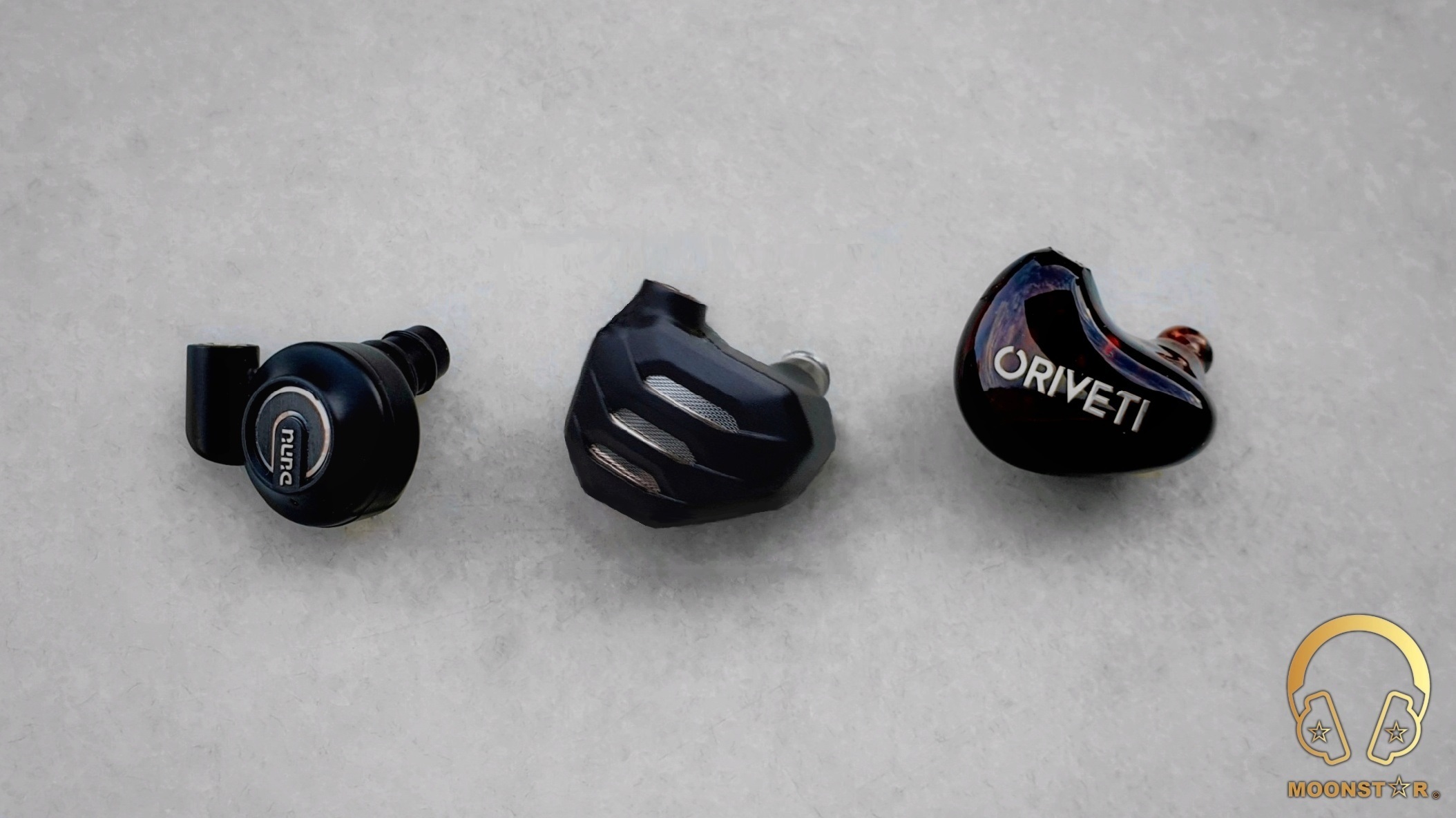
Conclusion:
The FH7S is a carefully tuned Hybrid Driver IEM from FiiO that shows well thought out entertaining sound profile with decent level of fun factor that can fine tuned with the interchangeable sound tuning filter. This sound is packed in to a very esthetic looking monitor shell with a solid build quality and pretty comfortable shape, which makes the FH7S ideal for longer listening periods. Moreover, it comes with a very rich accessory package that includes a good 8core detachable cable with swappable pugs, various ear tips inclusive FiiO’s new HS18 tips, a nice storage case and MMCX Assist tool.
Pros & Cons:
- + Carefully tuned entertaining sound profile with decent level of fun factor
- + Excellent Bass Performance (Depth, Speed and Authority)
- + Transparent & Airy Midrange Presentation
- + Smooth & Controlled Treble Response
- + Spacious Soundstage Atmosphere
- + Design, Comfort & Build Quality
- + Very Rich Set of Accessories (Swappable Plugs & Filters, HS18 Ear Tips, MMCX Assist Tool, etc.)
- – Upper & Lower Treble Extension is a bit short
- – Not for those who prefer a Reference Type of Sound Signature
- – 2.5mm Balanced Plug is missing that was included to previous models (FH5S Pro, FH9)
Thank you for the Read!
Last edited:
Dsnuts
Headphoneus Supremus
Pros: Supremely build, semi open all metal housing with hard plastic coating for durability.
Medium in size but ergonomic.
3 tuning nozzles for treble variations
19 pairs of tips including Spinfit CP145 tips and newly designed HS18 Fiio silicone tips
Excellent carry case lined with Velcro to attach your IEMs with.
Included LC-RC cable with 2 twist lock terminations. 3.5mm single and 4.4mm balanced
Musical full bodied large immersive sound experience excellent for media and music listening
Highly detailed and dimensional with full physical bass. S.turbo tech out of 13.6mm DLC
2 dual Knowles BAs made in conjunction with Fiio specs.
Large spacious stage that mimics a 5.1 sound signature.
Surprisingly capable for non-bass genres of music.
Very capable for bass genres of music.
Nowhere near shouty as some might think just based on looking at the graph
Tuned more for actual music listening, similar to how live music sounds.
Medium in size but ergonomic.
3 tuning nozzles for treble variations
19 pairs of tips including Spinfit CP145 tips and newly designed HS18 Fiio silicone tips
Excellent carry case lined with Velcro to attach your IEMs with.
Included LC-RC cable with 2 twist lock terminations. 3.5mm single and 4.4mm balanced
Musical full bodied large immersive sound experience excellent for media and music listening
Highly detailed and dimensional with full physical bass. S.turbo tech out of 13.6mm DLC
2 dual Knowles BAs made in conjunction with Fiio specs.
Large spacious stage that mimics a 5.1 sound signature.
Surprisingly capable for non-bass genres of music.
Very capable for bass genres of music.
Nowhere near shouty as some might think just based on looking at the graph
Tuned more for actual music listening, similar to how live music sounds.
Cons: Not the most traditionally accurate sound signature.
Nowhere near neutral in tuning. Not a con for me.
Will be too bassy for music purists.
Bass hump similar to how a 5.1 set up sounds like. Not a con for me.
Nowhere near neutral in tuning. Not a con for me.
Will be too bassy for music purists.
Bass hump similar to how a 5.1 set up sounds like. Not a con for me.
Fiio FH7S

One of Fiios most popular IEMS was their former flagship hybrid the FH7. With all the newer hybrid releases from Fiio it was only a matter of time before they came out with a successor to FH7 in the new FH7S. Their hybrid line of IEMs in general has seen much success but Fiio seems to have a certain sound profile they like to tune their earphones with and while it might not conform to a harmon neutral based in its tunings. I can tell they want something that will engage the listener and bring out the best traits of the drivers being used for the FH7s,
The new FH7S has a new housing that was first seen for their FH5S. The all-metal build seems to have a hard plastic type coating on the surface to ensure no blemishes or scratches can occur. Its matt black finish is nothing flashy but the edgy looks give them a mecha armor type design that gives them a newer modern look. The 3 screen meshes on the back of the shell effectively vents the drivers of the FH7S making them semi open in design. This has an effect on how you hear the FH7S sound so it is a part of its make up in how it was tuned. The new FH7S also comes with arguably one of the best included accessories packages in the market and even newer, an in house developed silicone tip set in the HS18 you can buy separately here.

One thing for certain is that you're not going to be left thinking how lame the cable is or how gimpy the tip selection is. Fiio makes sure from a consumer perspective that you are getting a king's ransom of nicely matching accessories with the new FH7S. 19 pairs of tips including premium spinfit CP145 tips and their newly developed HS18 tips.

I will gladly give Fiio an A grade for the presentation and what the FH7S comes with.

You are bound to find a good set of well-fitting tips for your ear shape and whether you're using the FH7S in single ended 3.5mm or balanced 4.4mm. Fiio got you covered as its cable includes their proprietary twist lock plugs in both terminations. Included with the lavish accessories set is one of the highest quality box clam shell type cases to carry around your precious FH7S in existence. I am a huge fan of these box cases Fiio provides as it comes lined with velcro attachments that form to any IEM you throw in them, which prevents the shells from clanking against each other.


Disclaimers: The Fiio FH7S Was provided by Fiio for the purpose of a review. If you feel the need to get yourself a musical set of FH7S for listening to your music with. You can find them on their Aliexpress web page here. The FH7S was burned in for period of a weeks' time. Now ready for evaluation using my sources. Ibasso DX300Max, Fiio M15, Fiio BTR7, Shanling M6 pro, M5s, IFI gryphon, IFI Signature, and Fiios K3 2021 edition on my laptop.

Build, form, function.
The FH7S is a semi open design and by nature they will not isolate as much as a fully closed all resin design. This being said, the passive isolation here is not bad. They certainly can be used outdoors especially since it has a powerful bass end to its sound qualities. I would say for semi open designs it is just slightly above average compared to other such designs. I would guess it is getting about 24dbs of passive isolation. The tradeoff for a semi open design is well worth it as the FH7S has a proper stage with a big spacious presentation for IEMs. The housing has a thick matt black finish coating making them scratch and fingerprint proof resistant. As far as builds go, I have complete confidence this housing and build is top notch. A grade for the build here. I know some folks prefer 2 pins vs the mmcx designs but the bottom line is, if you take care of your IEMs and know how to take a cable out properly than you will not have any issues with either type of connectors.

Its cable is the newer LC RC cable that was provided with the pro model for the FH5S pro edition. This cable is a monocrystalline copper-based cable plated in silver. It is more closer to higher end copper cables in properties which matches extremely well with the FH7S sound signature. And what can I say about modular cables. For an included cable I have no complaints here. Matching well with the sound profile of the FH7S.
Sound what you care about.
The FH7S being the younger sibling to the new flagship FH9. You can read my thoughts about them here. The FH7S conform to Fiios version of their musical bassy house signature. What is that you might ask? Well, is it one-part authoritative bass, one part forward vocals, another part large spacious balance. You get some form of these 3 ingredients to all of their more recent IEMS minus the FA7S which has the most neutral tuning out of all of the current Fiio line up.
For hybrid designs you have to bring out the best of what the drivers can do. But more often, we see much cheaper designs from hybrid IEMs that use a whole lot of drivers to be tuned in a manner where you are not really noticing how the drivers are being utilized. Why use a highly resolving Knowles BAs, 4 of them with a very capable large 13.6mm DLC dynamic driver to tune for a harmon neutral tuning? Fiio on the other hand clearly has optimized each driver on the FH7S for their given strengths.

But I get it. Purists will tell you, “ Based on the included graph, these will be shouty and too bassy. “ Ya ok how about actually listening to them and letting folks know how they actually sound? Here is where a graph does not exactly show how spacious, large and holographic a sound is. My point is yes these have coloration to its make up. They are tuned to immerse. They are indeed made for music listening, it is obvious to me as you will get a type of imaging that is almost impossible using a single or lesser quality drivers. These image in a larger scale with a spacious environment in how you're hearing your tracks. Not quite to the extent of the FH9 but it gets pretty damn close.
On top of that holographic presentation, it has details that are associated with a good BA implementation. It is the layering of the FH7S that is supreme in its presentation. Presents with very good height and depth and needless to say is a wide imaging IEM for hybrids. Its technicalities show the strengths of multiple BA arrangements and is a strong suit at the price range. Again back to the imaging, what won me over immediately was when I landed on a live recorded track. This is where I got a good taste of that dimensional imaging of the FH7S.
You can close your eyes and it is like you're there next to the artist. It is perhaps one of the very best IEMs for live music sets as it gets you ever so close to and how the ambience of the room the recording was made so accurately. Its dimensions and how they float about your hearing senses is extremely nice to hear. This was when I found myself saying. Wow!

Ok so back to reality. So what if the upper mids are a tad forward. This is how Fiio was able to tune with a forward center imaging. Vocals especially are projected forward in the mix but then has layers to its presentation with excellent depth to hear exactly where each instrument lies in the recording. Once again the purists will say. It is too forward. Don’t know about you but I don't mind having some beautiful singers whisper their lyrics into my ears. That's just me but that is actually a turn on for me. Goose bump instances. Yup these can do it. So why all the angst against an IEM you never heard and judge based on a graph. Plus when was the last time you seen a ruler flat neutral IEM made by Fiio?. Not too many to be honest. Their more recent Fiio FA7S comes the closest to a neutral type tuning but their hybrids? Not a single one of them are tuned that way. So what would make you think they will use overly large dynamic drivers with a boat load of BAs and tune them for neutral?
Well let me ask you this? How neutral is live music? These aren’t tuned to be IEM accurate. These are tuned to be musically accurate. How music is mixed in a concert performance for example. When have you ever heard a live concert with neutral bass? Think how that translates to an IEM presentation.

The FH7S is music forward but in a good way. This was done on purpose to immerse you. There is nothing that is laid back in its presentation. Isn’t that the very definition of being immersed? I suppose if you're a ruler flat neutral guy that loves 100% accuracy with a dry flat tuning. Ya I can see you being offended by the immersive sound qualities of the FH7S. But you know what? You can go look up other IEMs that will suit your needs more. But for folks that love them, some Holography for your musical presentations. READ ON!
Trebles.
Will be determined based on the 3 tuning caps. Its base configuration or the balanced cap gives a solid rendition of the trebles without being overly bright or strident. Here is the area I feel Fiio has improved their tuning since their FH5S. One method I test if there is too much treble or the dreaded treble glare is if crash cymbals sound a bit too forward.
This track is one of my go to tracks for treble. Too much forward treble causes fatigue and much like how the treble is tuned on their current hybrid flagship the FH9. The good news on the FH7S is that it clearly has some treble but seems to have a good balance of presence, proper transients and clarity all around. Nothing missing in its presentation: the trebles here are clean, crisp, defined and extend well.

Its red colored bass cap only reduces the treble aspects by a few dbs throwing the balancing of the FH7S to be a touch more warmer. This does not enhance the bass here but more curbs the treble via nozzle filter. Which is an old school trick to take a bit of the edge off the treble end. If you are a bass purist and love you some warmth to your tracks. This configuration will give the warmest tonal character overall vs the other caps.
Balanced white cap is just like it sounds but tonality is still a touch warm due to the thick bass line of the FH7S. Most of my review was done with the balanced cap. Its treble green cap brings the most treble but ends up actually balancing out the FH7S sound a touch better than the green cap due to the treble being about as elevated as the bass end. More treble, yes but is clearly listenable and brings a touch of extra clarity and articulation for the treble end with the most extension here.
Overall I have no issues with its treble presentation. Its relatively balanced treble if not a bit on the BA timbre aspect for its treble presentation. Good but not exceptional treble. Treble gets a B+ grade

Mids
It is the mids of the FH7S are tuned like how you would hear a live set. OK so the mids have some coloration here and you can clearly tell the bass end of the FH7S sounds is big and brawny. They do have a mid bass hump for its lower mids. Which ends up making them sound like a 5.1 set up in its presentation. These are clearly made for bass fans but the mids here will be more dependent on how you actually like your mids to be portrayed. If you want a clean mids presentation it will depend on the type of music you listen to. Generally instruments and vocals are clear with very good imaging throughout but some bass tracks do bring the sound a touch more forward from its mid and upper bass presence that makes some of the lower mids sound bigger and more forward..
You have to understand what type of tuning the FH7S is going for. It is clearly a bass focussed IEM but one that you can clearly listen to other genres with. Knowing that these are not neutral in any way or form. The mids here are done well especially if you don't mind some mids warmth from the bass emphasis. Which again ends up adding body and fullness to the mids presentation. On top of that a forward upper mids presentation and you get a forward vocal imaging with a full bodied sound, again a lot like a live music performance for your music. The mids gets a B grade here as well. Mids are not the most accurate nor do they give the cleanest presentation in terms of IEM balancing sense but if engagement factor takes precedence for how you like to hear your music. The FH7S is as emotive and versatile as I have heard a hybrid at this price range. Its wide large mid bands portray music intimately and there is nothing thin or dry about its sound quality. Utilizing some highly detailed Knowles BAs for its mids, the FH7S mids performance is highly musical a tad forward with very excellent imaging.

Lastly, that physical bass.
OK so here is the reason why you want to get a set of the FH7S. These use Fiios proprietary S. Turbo tube technology for its large and in-charge 13.6mm DLC dynamic that handles bass. Don’t expect neutral here from a 13.6mm DLC dynamic. What's the point of using such a potent capable dynamic driver if you're not going to bring the boom? The bass of these reminds me greatly of its older brother the FH9, so much so it looks like it is actually using the same dynamic drivers used on the FH9. Unless told otherwise, I am going to assume it is using the same.
I am very familiar with the bass end of the FH9 and here we get a similar impactful full bored brawny bass end to the FH7S. I am fairly certain Fiio folks are bass enthusiasts. I mean they included bass boost on their portable amps back in the day. Bass is clearly a part of their DAP signatures. Bass is a part of their dynamic IEM series and much more so on their hybrid series.

Bass here is a big, brawny, well textured and impactful powerful physical type bass. The type of bass you want to hear at shows and out and about. It has to be difficult to tune a relatively balanced tuning but also incorporating in its design, a big 13.6mm dynamic that is dedicated for bass. There is no mystery here in what Fiio is going for. These are for bass enthusiasts. You're not buying no neutral flat barely there bass IEM in the FH7S. What you're getting is something similar to a 5.1 speaker set up but for IEMs
The deep low hitting full rumbly well controlled bass here is about as tight and as defined as it will get for just how much physical bass you're actually getting. These clearly satisfy the basshead in me as it will others that are seeking a well defined bold bass end. For bass I will give it an A grade here. You just can't get big physical bass to be much better.

Now I have seen some complaints of how the bass overshadows the lower mids. I think if you accept what a 5.1 speaker profile is and how it is presented and think in terms of how that actually sounds vs IEMs. Something akin to your entertainment media speaker setup. OK now your starting to understand what Fiio was going for. And as such. The FH7S also happens to sound a lot like your entertainment system but inside your ears. You can’t tell me these don’t sound like a full THX theatre experience when watching movies and playing games.
Goes without saying Bass genres for music is going to perform on point. Your hiphop, EDM, RnB, pop, Jazz and reggae are going to be some of the best you will ever hear for earphones. Extremely impactful and entertaining. Yes indeed. But even for not bass genres these images so well they are very easy to like, especially for anything recorded live.
Truth is they do have a bass hump for the lower mids but how you gonna control this much dynamic ability for bass. When have you heard an external sub woofer actually not have a hump for the overall sound presentation? Is that really a bad thing? Well for purists yes but not so much if your like some added warmth to your music for that ultimate immersion quality.

Overall
I think Fiio got another winner here. I called the FH9 disco in your ears. The FH7S can do disco alright but are balanced well enough for versatility. Forward and bold to immerse and its imaging is one of the best for its class and for the type of sound it is going for. Know what type of sound profile these are and if you like that theatre type grand sound you will be a fan. So, you have to be a fan of an authoritative bass. Due to the big dynamic bass end of the FH7S. These make for perfect gaming and media IEMs. Movies and gaming sound spectacular on the FH7S and if you want a great media watching and playing IEM as well as your bassy music. These gets the thumbs up from me. Sure, there are IEMs that has a better, more even mid-range but not one that has this much bass. These fall into a fun sound signature that can sound very immersive for any type of media you're into.
Especially one that requires the right amount of boom and rumble. Fiio has provided a musical full bodied IEM tuning on the FH7S that has a big, scaled sound. If you're even remotely into your bass genres, you have to seriously consider what the FH7S offers. In a way it is like a cheaper alternative to its bigger brother the FH9 while not quite reaching the standards that bring the FH9 to another level in sound performance, the FH7S comes remarkably close but at $200 less. These are catering to folks that listen to music vs analyzing what is accurate, if you consider just how a 5.1 speaker setup might actually sound like in an IEM form, the Fiio FH7S comes very close. In those terms, the FH7S is a blast to listen to. We listen to music as a form of entertainment and if you're not entertained then what's the point. Thanks for taking the time to read. Happy listening always.

One of Fiios most popular IEMS was their former flagship hybrid the FH7. With all the newer hybrid releases from Fiio it was only a matter of time before they came out with a successor to FH7 in the new FH7S. Their hybrid line of IEMs in general has seen much success but Fiio seems to have a certain sound profile they like to tune their earphones with and while it might not conform to a harmon neutral based in its tunings. I can tell they want something that will engage the listener and bring out the best traits of the drivers being used for the FH7s,
The new FH7S has a new housing that was first seen for their FH5S. The all-metal build seems to have a hard plastic type coating on the surface to ensure no blemishes or scratches can occur. Its matt black finish is nothing flashy but the edgy looks give them a mecha armor type design that gives them a newer modern look. The 3 screen meshes on the back of the shell effectively vents the drivers of the FH7S making them semi open in design. This has an effect on how you hear the FH7S sound so it is a part of its make up in how it was tuned. The new FH7S also comes with arguably one of the best included accessories packages in the market and even newer, an in house developed silicone tip set in the HS18 you can buy separately here.

One thing for certain is that you're not going to be left thinking how lame the cable is or how gimpy the tip selection is. Fiio makes sure from a consumer perspective that you are getting a king's ransom of nicely matching accessories with the new FH7S. 19 pairs of tips including premium spinfit CP145 tips and their newly developed HS18 tips.

I will gladly give Fiio an A grade for the presentation and what the FH7S comes with.

You are bound to find a good set of well-fitting tips for your ear shape and whether you're using the FH7S in single ended 3.5mm or balanced 4.4mm. Fiio got you covered as its cable includes their proprietary twist lock plugs in both terminations. Included with the lavish accessories set is one of the highest quality box clam shell type cases to carry around your precious FH7S in existence. I am a huge fan of these box cases Fiio provides as it comes lined with velcro attachments that form to any IEM you throw in them, which prevents the shells from clanking against each other.


Disclaimers: The Fiio FH7S Was provided by Fiio for the purpose of a review. If you feel the need to get yourself a musical set of FH7S for listening to your music with. You can find them on their Aliexpress web page here. The FH7S was burned in for period of a weeks' time. Now ready for evaluation using my sources. Ibasso DX300Max, Fiio M15, Fiio BTR7, Shanling M6 pro, M5s, IFI gryphon, IFI Signature, and Fiios K3 2021 edition on my laptop.

Build, form, function.
The FH7S is a semi open design and by nature they will not isolate as much as a fully closed all resin design. This being said, the passive isolation here is not bad. They certainly can be used outdoors especially since it has a powerful bass end to its sound qualities. I would say for semi open designs it is just slightly above average compared to other such designs. I would guess it is getting about 24dbs of passive isolation. The tradeoff for a semi open design is well worth it as the FH7S has a proper stage with a big spacious presentation for IEMs. The housing has a thick matt black finish coating making them scratch and fingerprint proof resistant. As far as builds go, I have complete confidence this housing and build is top notch. A grade for the build here. I know some folks prefer 2 pins vs the mmcx designs but the bottom line is, if you take care of your IEMs and know how to take a cable out properly than you will not have any issues with either type of connectors.

Its cable is the newer LC RC cable that was provided with the pro model for the FH5S pro edition. This cable is a monocrystalline copper-based cable plated in silver. It is more closer to higher end copper cables in properties which matches extremely well with the FH7S sound signature. And what can I say about modular cables. For an included cable I have no complaints here. Matching well with the sound profile of the FH7S.
Sound what you care about.
The FH7S being the younger sibling to the new flagship FH9. You can read my thoughts about them here. The FH7S conform to Fiios version of their musical bassy house signature. What is that you might ask? Well, is it one-part authoritative bass, one part forward vocals, another part large spacious balance. You get some form of these 3 ingredients to all of their more recent IEMS minus the FA7S which has the most neutral tuning out of all of the current Fiio line up.
For hybrid designs you have to bring out the best of what the drivers can do. But more often, we see much cheaper designs from hybrid IEMs that use a whole lot of drivers to be tuned in a manner where you are not really noticing how the drivers are being utilized. Why use a highly resolving Knowles BAs, 4 of them with a very capable large 13.6mm DLC dynamic driver to tune for a harmon neutral tuning? Fiio on the other hand clearly has optimized each driver on the FH7S for their given strengths.

But I get it. Purists will tell you, “ Based on the included graph, these will be shouty and too bassy. “ Ya ok how about actually listening to them and letting folks know how they actually sound? Here is where a graph does not exactly show how spacious, large and holographic a sound is. My point is yes these have coloration to its make up. They are tuned to immerse. They are indeed made for music listening, it is obvious to me as you will get a type of imaging that is almost impossible using a single or lesser quality drivers. These image in a larger scale with a spacious environment in how you're hearing your tracks. Not quite to the extent of the FH9 but it gets pretty damn close.
On top of that holographic presentation, it has details that are associated with a good BA implementation. It is the layering of the FH7S that is supreme in its presentation. Presents with very good height and depth and needless to say is a wide imaging IEM for hybrids. Its technicalities show the strengths of multiple BA arrangements and is a strong suit at the price range. Again back to the imaging, what won me over immediately was when I landed on a live recorded track. This is where I got a good taste of that dimensional imaging of the FH7S.
You can close your eyes and it is like you're there next to the artist. It is perhaps one of the very best IEMs for live music sets as it gets you ever so close to and how the ambience of the room the recording was made so accurately. Its dimensions and how they float about your hearing senses is extremely nice to hear. This was when I found myself saying. Wow!

Ok so back to reality. So what if the upper mids are a tad forward. This is how Fiio was able to tune with a forward center imaging. Vocals especially are projected forward in the mix but then has layers to its presentation with excellent depth to hear exactly where each instrument lies in the recording. Once again the purists will say. It is too forward. Don’t know about you but I don't mind having some beautiful singers whisper their lyrics into my ears. That's just me but that is actually a turn on for me. Goose bump instances. Yup these can do it. So why all the angst against an IEM you never heard and judge based on a graph. Plus when was the last time you seen a ruler flat neutral IEM made by Fiio?. Not too many to be honest. Their more recent Fiio FA7S comes the closest to a neutral type tuning but their hybrids? Not a single one of them are tuned that way. So what would make you think they will use overly large dynamic drivers with a boat load of BAs and tune them for neutral?
Well let me ask you this? How neutral is live music? These aren’t tuned to be IEM accurate. These are tuned to be musically accurate. How music is mixed in a concert performance for example. When have you ever heard a live concert with neutral bass? Think how that translates to an IEM presentation.

The FH7S is music forward but in a good way. This was done on purpose to immerse you. There is nothing that is laid back in its presentation. Isn’t that the very definition of being immersed? I suppose if you're a ruler flat neutral guy that loves 100% accuracy with a dry flat tuning. Ya I can see you being offended by the immersive sound qualities of the FH7S. But you know what? You can go look up other IEMs that will suit your needs more. But for folks that love them, some Holography for your musical presentations. READ ON!
Trebles.
Will be determined based on the 3 tuning caps. Its base configuration or the balanced cap gives a solid rendition of the trebles without being overly bright or strident. Here is the area I feel Fiio has improved their tuning since their FH5S. One method I test if there is too much treble or the dreaded treble glare is if crash cymbals sound a bit too forward.
This track is one of my go to tracks for treble. Too much forward treble causes fatigue and much like how the treble is tuned on their current hybrid flagship the FH9. The good news on the FH7S is that it clearly has some treble but seems to have a good balance of presence, proper transients and clarity all around. Nothing missing in its presentation: the trebles here are clean, crisp, defined and extend well.

Its red colored bass cap only reduces the treble aspects by a few dbs throwing the balancing of the FH7S to be a touch more warmer. This does not enhance the bass here but more curbs the treble via nozzle filter. Which is an old school trick to take a bit of the edge off the treble end. If you are a bass purist and love you some warmth to your tracks. This configuration will give the warmest tonal character overall vs the other caps.
Balanced white cap is just like it sounds but tonality is still a touch warm due to the thick bass line of the FH7S. Most of my review was done with the balanced cap. Its treble green cap brings the most treble but ends up actually balancing out the FH7S sound a touch better than the green cap due to the treble being about as elevated as the bass end. More treble, yes but is clearly listenable and brings a touch of extra clarity and articulation for the treble end with the most extension here.
Overall I have no issues with its treble presentation. Its relatively balanced treble if not a bit on the BA timbre aspect for its treble presentation. Good but not exceptional treble. Treble gets a B+ grade

Mids
It is the mids of the FH7S are tuned like how you would hear a live set. OK so the mids have some coloration here and you can clearly tell the bass end of the FH7S sounds is big and brawny. They do have a mid bass hump for its lower mids. Which ends up making them sound like a 5.1 set up in its presentation. These are clearly made for bass fans but the mids here will be more dependent on how you actually like your mids to be portrayed. If you want a clean mids presentation it will depend on the type of music you listen to. Generally instruments and vocals are clear with very good imaging throughout but some bass tracks do bring the sound a touch more forward from its mid and upper bass presence that makes some of the lower mids sound bigger and more forward..
You have to understand what type of tuning the FH7S is going for. It is clearly a bass focussed IEM but one that you can clearly listen to other genres with. Knowing that these are not neutral in any way or form. The mids here are done well especially if you don't mind some mids warmth from the bass emphasis. Which again ends up adding body and fullness to the mids presentation. On top of that a forward upper mids presentation and you get a forward vocal imaging with a full bodied sound, again a lot like a live music performance for your music. The mids gets a B grade here as well. Mids are not the most accurate nor do they give the cleanest presentation in terms of IEM balancing sense but if engagement factor takes precedence for how you like to hear your music. The FH7S is as emotive and versatile as I have heard a hybrid at this price range. Its wide large mid bands portray music intimately and there is nothing thin or dry about its sound quality. Utilizing some highly detailed Knowles BAs for its mids, the FH7S mids performance is highly musical a tad forward with very excellent imaging.

Lastly, that physical bass.
OK so here is the reason why you want to get a set of the FH7S. These use Fiios proprietary S. Turbo tube technology for its large and in-charge 13.6mm DLC dynamic that handles bass. Don’t expect neutral here from a 13.6mm DLC dynamic. What's the point of using such a potent capable dynamic driver if you're not going to bring the boom? The bass of these reminds me greatly of its older brother the FH9, so much so it looks like it is actually using the same dynamic drivers used on the FH9. Unless told otherwise, I am going to assume it is using the same.
I am very familiar with the bass end of the FH9 and here we get a similar impactful full bored brawny bass end to the FH7S. I am fairly certain Fiio folks are bass enthusiasts. I mean they included bass boost on their portable amps back in the day. Bass is clearly a part of their DAP signatures. Bass is a part of their dynamic IEM series and much more so on their hybrid series.

Bass here is a big, brawny, well textured and impactful powerful physical type bass. The type of bass you want to hear at shows and out and about. It has to be difficult to tune a relatively balanced tuning but also incorporating in its design, a big 13.6mm dynamic that is dedicated for bass. There is no mystery here in what Fiio is going for. These are for bass enthusiasts. You're not buying no neutral flat barely there bass IEM in the FH7S. What you're getting is something similar to a 5.1 speaker set up but for IEMs
The deep low hitting full rumbly well controlled bass here is about as tight and as defined as it will get for just how much physical bass you're actually getting. These clearly satisfy the basshead in me as it will others that are seeking a well defined bold bass end. For bass I will give it an A grade here. You just can't get big physical bass to be much better.

Now I have seen some complaints of how the bass overshadows the lower mids. I think if you accept what a 5.1 speaker profile is and how it is presented and think in terms of how that actually sounds vs IEMs. Something akin to your entertainment media speaker setup. OK now your starting to understand what Fiio was going for. And as such. The FH7S also happens to sound a lot like your entertainment system but inside your ears. You can’t tell me these don’t sound like a full THX theatre experience when watching movies and playing games.
Goes without saying Bass genres for music is going to perform on point. Your hiphop, EDM, RnB, pop, Jazz and reggae are going to be some of the best you will ever hear for earphones. Extremely impactful and entertaining. Yes indeed. But even for not bass genres these images so well they are very easy to like, especially for anything recorded live.
Truth is they do have a bass hump for the lower mids but how you gonna control this much dynamic ability for bass. When have you heard an external sub woofer actually not have a hump for the overall sound presentation? Is that really a bad thing? Well for purists yes but not so much if your like some added warmth to your music for that ultimate immersion quality.

Overall
I think Fiio got another winner here. I called the FH9 disco in your ears. The FH7S can do disco alright but are balanced well enough for versatility. Forward and bold to immerse and its imaging is one of the best for its class and for the type of sound it is going for. Know what type of sound profile these are and if you like that theatre type grand sound you will be a fan. So, you have to be a fan of an authoritative bass. Due to the big dynamic bass end of the FH7S. These make for perfect gaming and media IEMs. Movies and gaming sound spectacular on the FH7S and if you want a great media watching and playing IEM as well as your bassy music. These gets the thumbs up from me. Sure, there are IEMs that has a better, more even mid-range but not one that has this much bass. These fall into a fun sound signature that can sound very immersive for any type of media you're into.
Especially one that requires the right amount of boom and rumble. Fiio has provided a musical full bodied IEM tuning on the FH7S that has a big, scaled sound. If you're even remotely into your bass genres, you have to seriously consider what the FH7S offers. In a way it is like a cheaper alternative to its bigger brother the FH9 while not quite reaching the standards that bring the FH9 to another level in sound performance, the FH7S comes remarkably close but at $200 less. These are catering to folks that listen to music vs analyzing what is accurate, if you consider just how a 5.1 speaker setup might actually sound like in an IEM form, the Fiio FH7S comes very close. In those terms, the FH7S is a blast to listen to. We listen to music as a form of entertainment and if you're not entertained then what's the point. Thanks for taking the time to read. Happy listening always.
Last edited:
obileye obiyemi
A comparison with the EST50 please?
Dsnuts
FH7S is more on the lines of consumer bassy. The EST50 is more on the lines of audiophile bassy. FH7s both have pronounced bass and rumble but Fiios S-Turbo tech for bass focuses bass to a point where it literally sounds like a sub woofer. The EST50 also has some brawny bass but is more rumbly than mid bassy like the FH7S.
Mids on both sets are good but EST50 is using Sonion BA which brings a more richer tonal character vs the FH7S dual knowles BAs. I would say the FH7S images with a bit more dimensional character the EST50 is more richer and has better texture for its sound from bass to treble with less BA timbre vs the FH7S. Treble the EST50 is more smoother sounding vs the FH7S which has more treble presence. Both sets are a blast to listen to but the EST50 has a bit more refinements going for it. FH7S has its own flavor though. BASS heads would probably like the FH7S a bit more. Audiophile bass fans would like the EST50s more.
Mids on both sets are good but EST50 is using Sonion BA which brings a more richer tonal character vs the FH7S dual knowles BAs. I would say the FH7S images with a bit more dimensional character the EST50 is more richer and has better texture for its sound from bass to treble with less BA timbre vs the FH7S. Treble the EST50 is more smoother sounding vs the FH7S which has more treble presence. Both sets are a blast to listen to but the EST50 has a bit more refinements going for it. FH7S has its own flavor though. BASS heads would probably like the FH7S a bit more. Audiophile bass fans would like the EST50s more.
chowmein83
500+ Head-Fier
Pros: - Carefully-tuned fun sound signature
- Massive soundstage and accurate imaging
- Great technical abilities
- Excellent bass quality
- Scales well with better sources
- Great cable and build quality
- Massive soundstage and accurate imaging
- Great technical abilities
- Excellent bass quality
- Scales well with better sources
- Great cable and build quality
Cons: - Filters are a bit hard to change
- HS18 eartips are a bit finicky
- Not neutral with any filter (this is debatable if this is a con)
- Not as isolating as other IEMs
- HS18 eartips are a bit finicky
- Not neutral with any filter (this is debatable if this is a con)
- Not as isolating as other IEMs
Before moving on with the rest of my review, I would like to thank FiiO for providing me with a review sample of the FH7S in exchange for my opinions.
(Please forgive the lack of pictures here – I may put some later when I have more time.)
Intro
The FH7S is a 1 DD 4 BA per ear IEM, priced at $400 MSRP. What’s notable is that it uses the same dynamic driver as the FH9, and according to FiiO the FH7S is designed to channel the essence of the FH9 into a package with fewer drivers.
What’s included
I won’t bore with you with text here, the video above shows you what’s exactly in the box. Suffice to say there’s plenty of accessories to make your life with the FH7S easy. The only omission perhaps is a lack of 2.5mm balanced tip for the cable, but this may not matter much as more and more devices are adopting 4.4mm balanced.
Comfort, Ergonomics, and Build Quality
Build quality is excellent – both the IEM and the cable itself. Both feel solid and well finished (not cheap). It is very easy to change out the heads on the cable.
It is quite comfortable despite its large size. The metal finish is cool and comfortable to the touch and FH7S is curved to better fit your ear. However, the size is almost at the limit of what I would consider comfortable, and pairing it with larger eartips like the foam ones included does make it a bit uncomfortable.
Its semi-open nature means that it doesn’t isolate as well, and is more susceptible to its perceived frequency response being affected by environmental noise (usually bass). It still isolates to a certain extent, but definitely not as good as the typical closed IEM. (Like the FLC8S.)
The filters are really tiny and easy to lose, and are also not the easiest to change out. This is due to its tiny size and lack of grippable area to hold on to when unscrewing tips to change them. Perhaps a system like the ridged edges of the FLC8S filters (and with the entire filter itself being color-coded for easy identification) would make it easier to change filters.
One note about tips – there are plenty of tips included that do make an audible sound difference to choose from. Personally, I ended up using the new HS18 eartips not only because they sounded the best to me (more on that in the sound section), but also because they were the most comfortable. Being very thin meant they disappeared in your ears comfort-wise. However, because they are so thin you have to be careful how you put them in your ears – in my experience, their thinness means they more easily fold up on itself which means lack of seal.
Sound
Listening sources – most of my listening was done on the FiiO Q5 and X7 Mk2 with AM3B and AM3D amp modules. I also did some listening on an Xperia 1 II smartphone and on desktop setups (Teac UD-505 DAC/amp combo; and NuForce UDH-100 DAC paired with Monoprice-Cavalli Liquid Gold X).
Bass – This is the star of the show. The bass dynamic driver is not only very quick and controlled, but very dynamic and really slams (lots of weight and impact to it). It’s really capable of showing texture in bass notes. No matter which tips and filters you use, remarkably the bass never overshadows the mids (but it’s just right at the limit of doing so). There is maybe a slight mid-bass emphasis but sub-bass still comes through very powerfully.
Mids – If you get it in the sweet spot, vocals are actually very detailed and smooth, and with decent weight behind them. However, mids are tuned right at the limit of not being sibilant. Depending on your source, music, filters, and eartips, they may be a bit too much – but just a bit too much, mids are never really harsh.
Treble – This is actually a touch reserved. Treble is never really dark, but it is there and never calls too much attention to itself. Not to say that the treble is bad, it’s good because it works with good detail and it is not piercing.
Soundstage – Very wide and very deep – definitely a highlight of the FH7S. Depth especially is noticeably better than most IEMs I’ve heard before. Sounds are also separated very well and are precisely placed within the stage – both horizontal-wise and depth-wise.
Speed – Overall, the FH7S is no slouch in the speed department. I already mentioned the bass dynamic driver’s speed before, but the mid and treble BAs can keep up pretty well with even the most complicated orchestral music.
Dynamics – Pretty decent dynamics. I’ve already mentioned how the bass dynamic driver has great dynamics drivers, but overall the FH7S does very well in illuminating volume swings in your music – making stuff like classical and orchestral feel suitably epic. Music doesn’t definitely sound unnecessarily flat with the FH7S.
Sound signature
As I alluded to before, the FH7S has an overall fun sound signature where the bass and the mids are cranked up right to the max before they start interfering with each other and the other parts of the frequency spectrum – this is definitely not a neutral IEM. There is a bass and mid emphasis no matter which set of eartips or filters you use, but the FH7S sound signature can change quite a bit from rolling those two elements.
Eartips – My favorites were the HS18 tips, followed closely by the SpinFit tips. To me, both of these had a similar sound signature (a bit more present but relatively more well-controlled bass and present mids and trebles), but the HS18 edged out the SpinFit tips for me due to its slightly smoother mids and vocals. The pre-installed “balanced eartips” had a bit less-controlled bass and a bit too much mids for me.
Filters –
Red - While the red filters are advertised as “bass” filters, I’m not sure if I would label the FH7S as a basshead IEM in that configuration. The sound signature with this filter is more like a warm sound but with a bass emphasis. I say this because the mids and treble are noticeably brought down compared to the other filters, but the bass also loses a bit of its slam and explosiveness in this configuration. Not my preferred configuration, but it does show how much the sound signature of the FH7S can change with the provided accessories.
White – Mids and highs are noticeably more present – and sound more correct to me than under the red filter. Mids can start to be a bit overbearing depending on the track, but most of the time this is not a problem. Bass also seems more explosive and “effortless” under this filter. However, while the bass still doesn’t overshadow mids and vocals, this is definitely still a more “fun” sound signature and not neutral reference. I listened to this configuration the most.
Green – basically like White, but with noticeably more mids and treble so that bass takes more of a backseat. But this configuration just gives more of the mids and treble, not that they are any harsher. However, depending on the track the bass is still surprisingly present. The green filter gets closer to a neutral sound signature but I still wouldn’t call it that because the bass can sometimes come back with a vengeance.
Source scaling – While the FH7S sounds good out of most sources, it does notably come more alive with better sources. There was a noticeable jump in detail, dynamics, and bass control when I switched from listening to the FH7S out of my smartphone to the Q5 and X7 Mk2. Just for fun, I decided to plug in the FH7S into desktop equipment and was pleasantly surprised – detail seemed to get even better and bass also notably became more dynamic yet more well-controlled at the same time. Just beware that the FH7S is sensitive enough that it can pick up noise if your amp isn’t the cleanest. (This was only a problem with some of the noisier outputs of my desktop setups.) Soundstage wise this doesn’t really scale with the source, as you’re already getting most of its imaging and layering prowess even with the lowliest source.
Conclusion
The FH7S is a carefully-tuned fun-sounding IEM that’s well rounded – as long as you’re not expecting strict neutrality and you’re ok with slightly elevated mids. It’s comfortable, built well, comes with lots of accessories, and sounds great (musically and technically). Recommended.
(Please forgive the lack of pictures here – I may put some later when I have more time.)
Intro
The FH7S is a 1 DD 4 BA per ear IEM, priced at $400 MSRP. What’s notable is that it uses the same dynamic driver as the FH9, and according to FiiO the FH7S is designed to channel the essence of the FH9 into a package with fewer drivers.
What’s included
I won’t bore with you with text here, the video above shows you what’s exactly in the box. Suffice to say there’s plenty of accessories to make your life with the FH7S easy. The only omission perhaps is a lack of 2.5mm balanced tip for the cable, but this may not matter much as more and more devices are adopting 4.4mm balanced.
Comfort, Ergonomics, and Build Quality
Build quality is excellent – both the IEM and the cable itself. Both feel solid and well finished (not cheap). It is very easy to change out the heads on the cable.
It is quite comfortable despite its large size. The metal finish is cool and comfortable to the touch and FH7S is curved to better fit your ear. However, the size is almost at the limit of what I would consider comfortable, and pairing it with larger eartips like the foam ones included does make it a bit uncomfortable.
Its semi-open nature means that it doesn’t isolate as well, and is more susceptible to its perceived frequency response being affected by environmental noise (usually bass). It still isolates to a certain extent, but definitely not as good as the typical closed IEM. (Like the FLC8S.)
The filters are really tiny and easy to lose, and are also not the easiest to change out. This is due to its tiny size and lack of grippable area to hold on to when unscrewing tips to change them. Perhaps a system like the ridged edges of the FLC8S filters (and with the entire filter itself being color-coded for easy identification) would make it easier to change filters.
One note about tips – there are plenty of tips included that do make an audible sound difference to choose from. Personally, I ended up using the new HS18 eartips not only because they sounded the best to me (more on that in the sound section), but also because they were the most comfortable. Being very thin meant they disappeared in your ears comfort-wise. However, because they are so thin you have to be careful how you put them in your ears – in my experience, their thinness means they more easily fold up on itself which means lack of seal.
Sound
Listening sources – most of my listening was done on the FiiO Q5 and X7 Mk2 with AM3B and AM3D amp modules. I also did some listening on an Xperia 1 II smartphone and on desktop setups (Teac UD-505 DAC/amp combo; and NuForce UDH-100 DAC paired with Monoprice-Cavalli Liquid Gold X).
Bass – This is the star of the show. The bass dynamic driver is not only very quick and controlled, but very dynamic and really slams (lots of weight and impact to it). It’s really capable of showing texture in bass notes. No matter which tips and filters you use, remarkably the bass never overshadows the mids (but it’s just right at the limit of doing so). There is maybe a slight mid-bass emphasis but sub-bass still comes through very powerfully.
Mids – If you get it in the sweet spot, vocals are actually very detailed and smooth, and with decent weight behind them. However, mids are tuned right at the limit of not being sibilant. Depending on your source, music, filters, and eartips, they may be a bit too much – but just a bit too much, mids are never really harsh.
Treble – This is actually a touch reserved. Treble is never really dark, but it is there and never calls too much attention to itself. Not to say that the treble is bad, it’s good because it works with good detail and it is not piercing.
Soundstage – Very wide and very deep – definitely a highlight of the FH7S. Depth especially is noticeably better than most IEMs I’ve heard before. Sounds are also separated very well and are precisely placed within the stage – both horizontal-wise and depth-wise.
Speed – Overall, the FH7S is no slouch in the speed department. I already mentioned the bass dynamic driver’s speed before, but the mid and treble BAs can keep up pretty well with even the most complicated orchestral music.
Dynamics – Pretty decent dynamics. I’ve already mentioned how the bass dynamic driver has great dynamics drivers, but overall the FH7S does very well in illuminating volume swings in your music – making stuff like classical and orchestral feel suitably epic. Music doesn’t definitely sound unnecessarily flat with the FH7S.
Sound signature
As I alluded to before, the FH7S has an overall fun sound signature where the bass and the mids are cranked up right to the max before they start interfering with each other and the other parts of the frequency spectrum – this is definitely not a neutral IEM. There is a bass and mid emphasis no matter which set of eartips or filters you use, but the FH7S sound signature can change quite a bit from rolling those two elements.
Eartips – My favorites were the HS18 tips, followed closely by the SpinFit tips. To me, both of these had a similar sound signature (a bit more present but relatively more well-controlled bass and present mids and trebles), but the HS18 edged out the SpinFit tips for me due to its slightly smoother mids and vocals. The pre-installed “balanced eartips” had a bit less-controlled bass and a bit too much mids for me.
Filters –
Red - While the red filters are advertised as “bass” filters, I’m not sure if I would label the FH7S as a basshead IEM in that configuration. The sound signature with this filter is more like a warm sound but with a bass emphasis. I say this because the mids and treble are noticeably brought down compared to the other filters, but the bass also loses a bit of its slam and explosiveness in this configuration. Not my preferred configuration, but it does show how much the sound signature of the FH7S can change with the provided accessories.
White – Mids and highs are noticeably more present – and sound more correct to me than under the red filter. Mids can start to be a bit overbearing depending on the track, but most of the time this is not a problem. Bass also seems more explosive and “effortless” under this filter. However, while the bass still doesn’t overshadow mids and vocals, this is definitely still a more “fun” sound signature and not neutral reference. I listened to this configuration the most.
Green – basically like White, but with noticeably more mids and treble so that bass takes more of a backseat. But this configuration just gives more of the mids and treble, not that they are any harsher. However, depending on the track the bass is still surprisingly present. The green filter gets closer to a neutral sound signature but I still wouldn’t call it that because the bass can sometimes come back with a vengeance.
Source scaling – While the FH7S sounds good out of most sources, it does notably come more alive with better sources. There was a noticeable jump in detail, dynamics, and bass control when I switched from listening to the FH7S out of my smartphone to the Q5 and X7 Mk2. Just for fun, I decided to plug in the FH7S into desktop equipment and was pleasantly surprised – detail seemed to get even better and bass also notably became more dynamic yet more well-controlled at the same time. Just beware that the FH7S is sensitive enough that it can pick up noise if your amp isn’t the cleanest. (This was only a problem with some of the noisier outputs of my desktop setups.) Soundstage wise this doesn’t really scale with the source, as you’re already getting most of its imaging and layering prowess even with the lowliest source.
Conclusion
The FH7S is a carefully-tuned fun-sounding IEM that’s well rounded – as long as you’re not expecting strict neutrality and you’re ok with slightly elevated mids. It’s comfortable, built well, comes with lots of accessories, and sounds great (musically and technically). Recommended.
chowmein83
@NickT23 Yes, I did try it with my Sony Xperia I Mk2. It was decent, but the FH7S definitely benefits from being plugged into a better source.
Leonne
a guy on YT said mid freq was a touch too thick/ muddy (i forgot the exact word) but is that true?
chowmein83
@Leonne I personally don't think the mids are too thick or muddy. In fact, I think they have a nice weight to them actually.



I really appreciated your very relevant comparison with the FiiO FH9.
And it's a great pleasure to see a review with a nice cd cover, a marvellous Alpha recording!